Attached files
| file | filename |
|---|---|
| EX-99.1 - EX-99.1 - FEDERAL NATIONAL MORTGAGE ASSOCIATION FANNIE MAE | fnma2020q3pressrelease.htm |
| 8-K - 8-K - FEDERAL NATIONAL MORTGAGE ASSOCIATION FANNIE MAE | fnm-20201029.htm |

Exhibit 99.2 Financial Supplement Q3 2020 October 29, 2020 © 2020 Fannie Mae
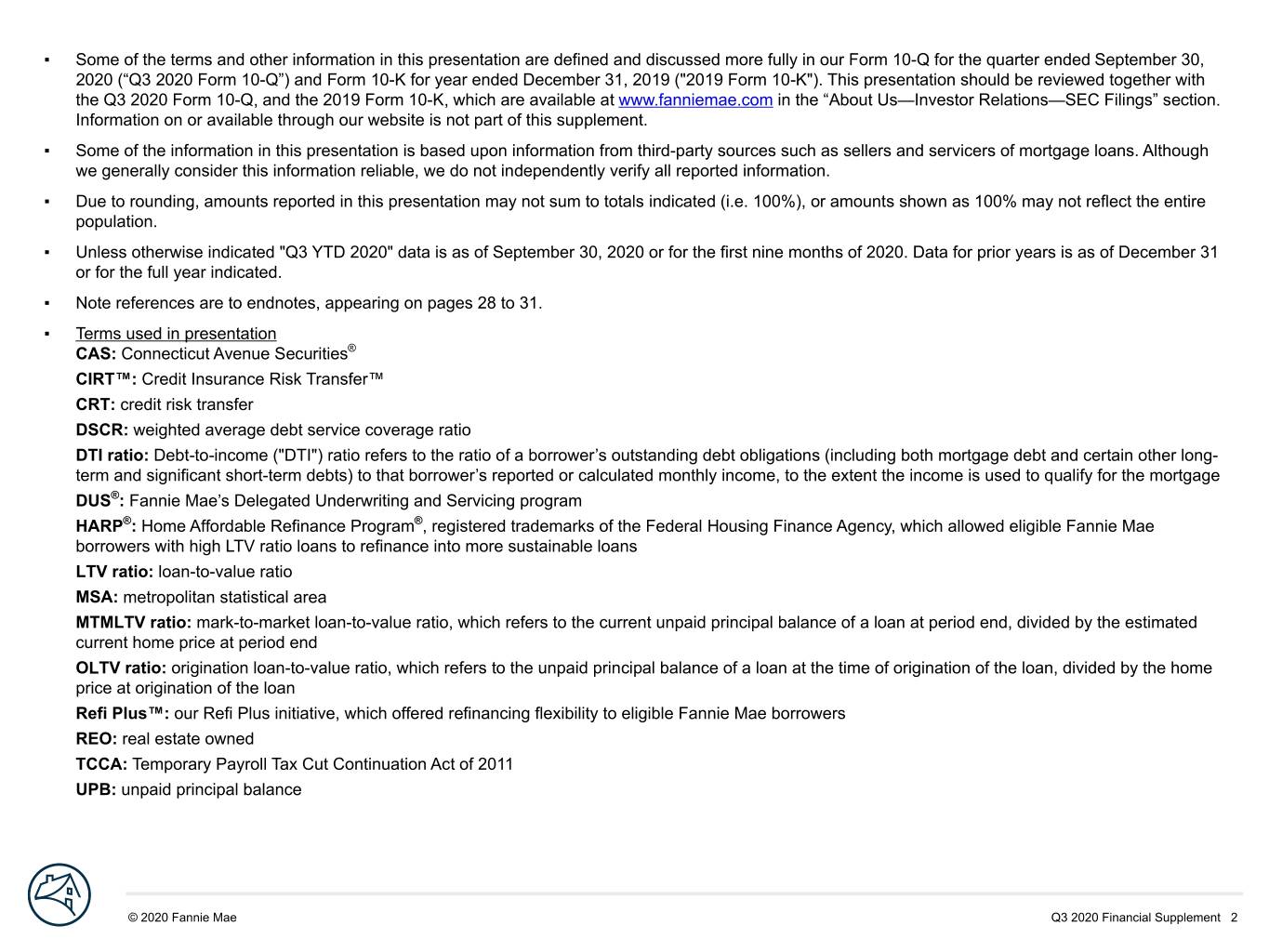
DRAFT ▪ Some of the terms and other information in this presentation are defined and discussed more fully in our Form 10-Q for the quarter ended September 30, 2020 (“Q3 2020 Form 10-Q”) and Form 10-K for year ended December 31, 2019 ("2019 Form 10-K"). This presentation should be reviewed together with the Q3 2020 Form 10-Q, and the 2019 Form 10-K, which are available at www.fanniemae.com in the “About Us—Investor Relations—SEC Filings” section. Information on or available through our website is not part of this supplement. ▪ Some of the information in this presentation is based upon information from third-party sources such as sellers and servicers of mortgage loans. Although we generally consider this information reliable, we do not independently verify all reported information. ▪ Due to rounding, amounts reported in this presentation may not sum to totals indicated (i.e. 100%), or amounts shown as 100% may not reflect the entire population. ▪ Unless otherwise indicated "Q3 YTD 2020" data is as of September 30, 2020 or for the first nine months of 2020. Data for prior years is as of December 31 or for the full year indicated. ▪ Note references are to endnotes, appearing on pages 28 to 31. ▪ Terms used in presentation CAS: Connecticut Avenue Securities® CIRT™: Credit Insurance Risk Transfer™ CRT: credit risk transfer DSCR: weighted average debt service coverage ratio DTI ratio: Debt-to-income ("DTI") ratio refers to the ratio of a borrower’s outstanding debt obligations (including both mortgage debt and certain other long- term and significant short-term debts) to that borrower’s reported or calculated monthly income, to the extent the income is used to qualify for the mortgage DUS®: Fannie Mae’s Delegated Underwriting and Servicing program HARP®: Home Affordable Refinance Program®, registered trademarks of the Federal Housing Finance Agency, which allowed eligible Fannie Mae borrowers with high LTV ratio loans to refinance into more sustainable loans LTV ratio: loan-to-value ratio MSA: metropolitan statistical area MTMLTV ratio: mark-to-market loan-to-value ratio, which refers to the current unpaid principal balance of a loan at period end, divided by the estimated current home price at period end OLTV ratio: origination loan-to-value ratio, which refers to the unpaid principal balance of a loan at the time of origination of the loan, divided by the home price at origination of the loan Refi Plus™: our Refi Plus initiative, which offered refinancing flexibility to eligible Fannie Mae borrowers REO: real estate owned TCCA: Temporary Payroll Tax Cut Continuation Act of 2011 UPB: unpaid principal balance © 2020 Fannie Mae Q3 2020 Financial Supplement 2

Table of Contents DRAFT Overview Corporate Financial Highlights 5 Guaranty Book of Business Highlights 6 Single-Family Credit Characteristics 7 Multifamily Credit Characteristics 8 Single-Family and Multifamily Conventional Guaranty Books of Business in Forbearance 9 Portfolio and Liquidity Management 10 Key Market Economic Indicators 11 Net Worth, Treasury Funding and Senior Preferred Stock Dividends 12 Single-Family Business Single-Family Highlights 14 Credit Characteristics of Single-Family Conventional Loan Acquisitions 15 Credit Characteristics of Single-Family Conventional Guaranty Book of Business 16 Single-Family Credit Risk Transfer 17 Single-Family Conventional Guaranty Book of Business in Forbearance 18 Single-Family Problem Loan Statistics 19 Credit Loss Concentration of Single-Family Conventional Guaranty Book of Business 20 Single-Family Cumulative Default Rates 21 Multifamily Business Multifamily Highlights 23 Credit Characteristics of Multifamily Loan Acquisitions 24 Credit Characteristics of Multifamily Guaranty Book of Business 25 Multifamily Serious Delinquency Rates and Credit Losses 26 Endnotes Endnotes 28 © 2020 Fannie Mae Q3 2020 Financial Supplement 3

DRAFT Overview © 2020 Fannie Mae

DRAFT Corporate Financial Highlights Summary of Q3 2020 Financial Results Q3 Key Financial Highlights Q3 YTD Q3 YTD Comprehensive income increased (Dollars in millions) Q3 2020 Q2 2020 Variance 2020 2019 Variance $1.7 billion from Q2 2020 to $4.2 billion for Q3 2020 Net interest income(1) $6,656 $5,777 $879 $17,780 $15,371 $2,409 • Prepayment volumes are at record highs Fee and other income 93 90 3 303 435 (132) due to the historically low interest rate environment, driving an increase from Net revenues 6,749 5,867 882 18,083 15,806 2,277 Q2 2020 in net interest income. • Net fair value losses decreased in Q3 Investment gains, net 653 149 504 644 847 (203) 2020 compared with the Q2 2020 primarily due to (1) a decrease in losses on debt reported at fair value due to Fair value losses, net (327) (1,018) 691 (1,621) (2,298) 677 yields remaining mostly flat during Q3 2020 compared to declines in Q2 2020 Administrative expenses (762) (754) (8) (2,265) (2,237) (28) and (2) gains on credit enhancement derivatives as higher loan default Total credit-related income (expense) 430 (22) 452 (2,255) 3,368 (5,623) expectations led to an increase in the fair value of risk-sharing securities covering those loans. TCCA fees (679) (660) (19) (1,976) (1,806) (170) • The company sold $4.0 billion UPB of single-family reperforming loans in Q3 Other expenses, net (686) (348) (338) (1,440) (1,333) (107) 2020 resulting in $0.4 billion of Income before federal income investment gains. taxes 5,378 3,214 2,164 9,170 12,347 (3,177) • The company redesignated $5.7 billion Provision for federal income UPB of single-family reperforming loans taxes (1,149) (669) (480) (1,935) (2,552) 617 in Q3 2020 from held for investment ("HFI") to held for sale ("HFS"), resulting Net income $4,229 $2,545 $1,684 $7,235 $9,795 $(2,560) in $0.5 billion of credit-related income; credit-related income also benefited from Total comprehensive improved actual and forecasted home income $4,216 $2,532 $1,684 $7,224 $9,703 $(2,479) prices, partially offset by higher expense for losses the company expects as a Net worth $20,693 $16,477 $20,693 $10,342 result of COVID-19. © 2020 Fannie Mae Q3 2020 Financial Supplement 5
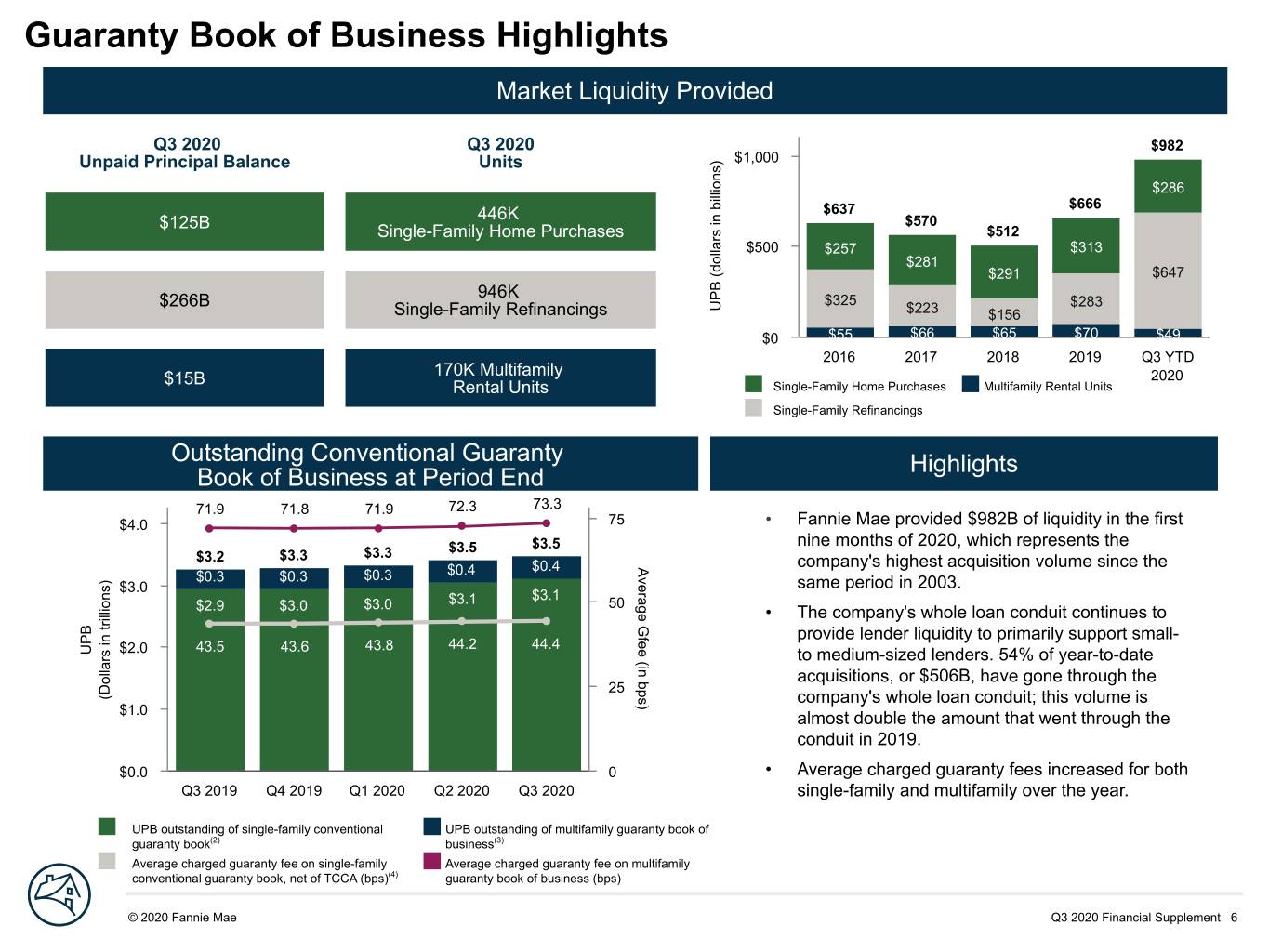
Guaranty Book of Business Highlights DRAFT Market Liquidity Provided Q3 2020 Q3 2020 $982 Unpaid Principal Balance Units $1,000 $286 $637 $666 $125B 446K $570 Single-Family Home Purchases $512 $500 $257 $313 $281 $291 $647 946K $266B $325 $283 Single-Family Refinancings UP B (dollars in billions) $223 $156 $55 $66 $65 $70 $49 $0 2016 2017 2018 2019 Q3 YTD $15B 170K Multifamily 2020 Rental Units Single-Family Home Purchases Multifamily Rental Units Single-Family Refinancings Outstanding Conventional Guaranty Highlights Book of Business at Period End 71.9 71.8 71.9 72.3 73.3 $4.0 75 • Fannie Mae provided $982B of liquidity in the first $3.5 $3.5 nine months of 2020, which represents the $3.2 $3.3 $3.3 $0.4 Av erage Gfee (in bps) company's highest acquisition volume since the $0.3 $0.3 $0.3 $0.4 $3.0 same period in 2003. $3.1 $3.1 50 $2.9 $3.0 $3.0 • The company's whole loan conduit continues to provide lender liquidity to primarily support small- 43.5 43.6 43.8 44.2 44.4 UP B $2.0 to medium-sized lenders. 54% of year-to-date acquisitions, or $506B, have gone through the 25 (D ollars in trillions) company's whole loan conduit; this volume is $1.0 almost double the amount that went through the conduit in 2019. $0.0 0 • Average charged guaranty fees increased for both Q3 2019 Q4 2019 Q1 2020 Q2 2020 Q3 2020 single-family and multifamily over the year. UPB outstanding of single-family conventional UPB outstanding of multifamily guaranty book of guaranty book(2) business(3) Average charged guaranty fee on single-family Average charged guaranty fee on multifamily conventional guaranty book, net of TCCA (bps)(4) guaranty book of business (bps) © 2020 Fannie Mae Q3 2020 Financial Supplement 6
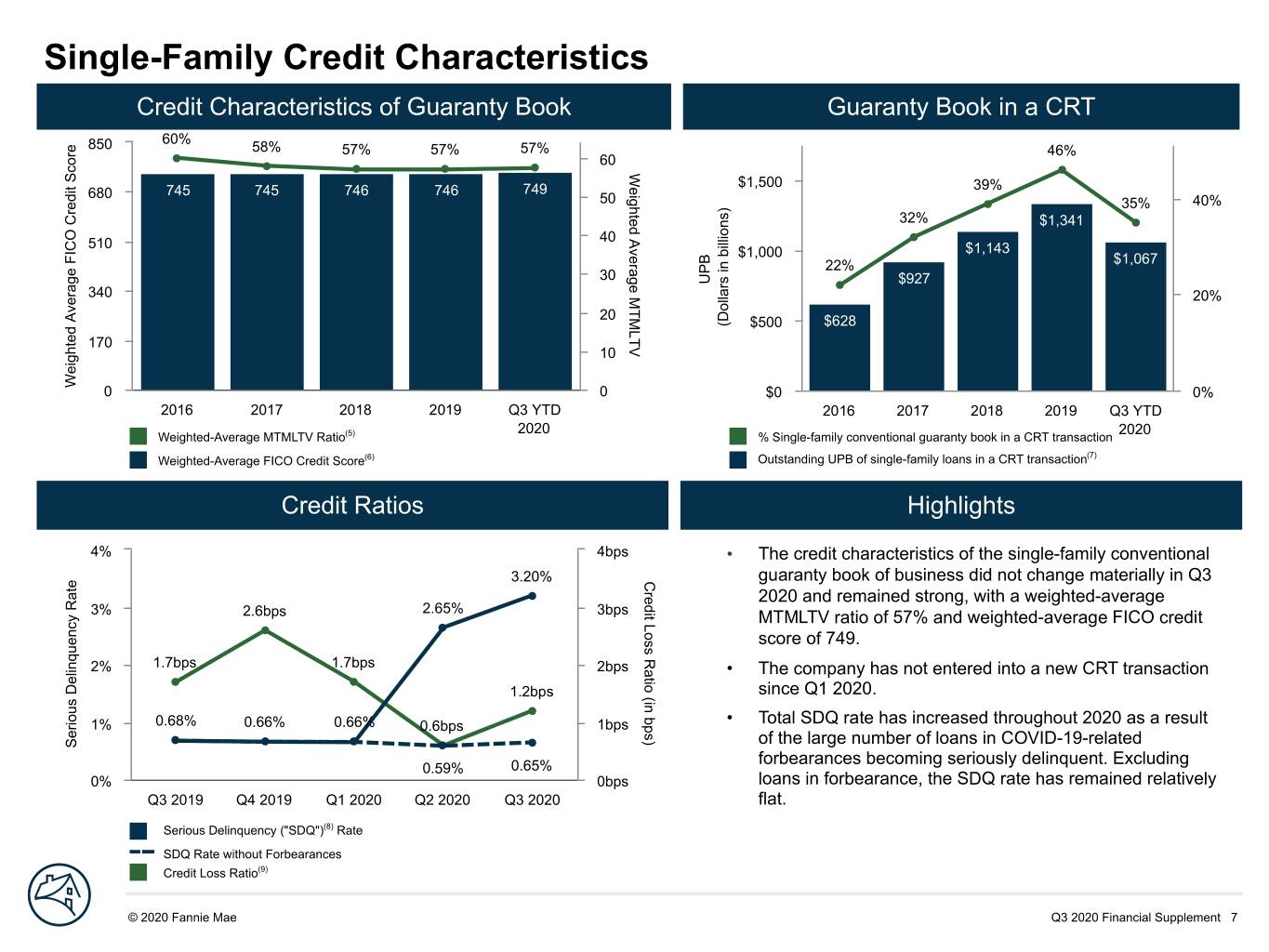
DRAFT Single-Family Credit Characteristics Credit Characteristics of Guaranty Book Guaranty Book in a CRT 60% 850 58% 57% 57% 57% 46% 60 We ighted Average MTMLTV $1,500 39% 680 745 745 746 746 749 50 35% 40% 32% $1,341 510 40 $1,000 $1,143 22% $1,067 30 UP B $927 340 20% 20 (D ollars in billions) $500 $628 170 10 We ighted Average FICO Credit Score 0 0 $0 0% 2016 2017 2018 2019 Q3 YTD 2016 2017 2018 2019 Q3 YTD 2020 2020 Weighted-Average MTMLTV Ratio(5) % Single-family conventional guaranty book in a CRT transaction Weighted-Average FICO Credit Score(6) Outstanding UPB of single-family loans in a CRT transaction(7) Credit Ratios Highlights 4% 4bps • The credit characteristics of the single-family conventional 3.20% Cr edit Loss Ratio (in bps) guaranty book of business did not change materially in Q3 2020 and remained strong, with a weighted-average 2.65% 3% 2.6bps 3bps MTMLTV ratio of 57% and weighted-average FICO credit score of 749. 1.7bps 1.7bps 2% 2bps • The company has not entered into a new CRT transaction 1.2bps since Q1 2020. 0.68% • Total SDQ rate has increased throughout 2020 as a result 1% 0.66% 0.66% 0.6bps 1bps of the large number of loans in COVID-19-related Se rious Delinquency Rate forbearances becoming seriously delinquent. Excluding 0.68% 0.66% 0.66% 0.59% 0.65% 0% 0bps loans in forbearance, the SDQ rate has remained relatively Q3 2019 Q4 2019 Q1 2020 Q2 2020 Q3 2020 flat. Serious Delinquency ("SDQ")(8) Rate SDQ Rate without Forbearances Credit Loss Ratio(9) © 2020 Fannie Mae Q3 2020 Financial Supplement 7
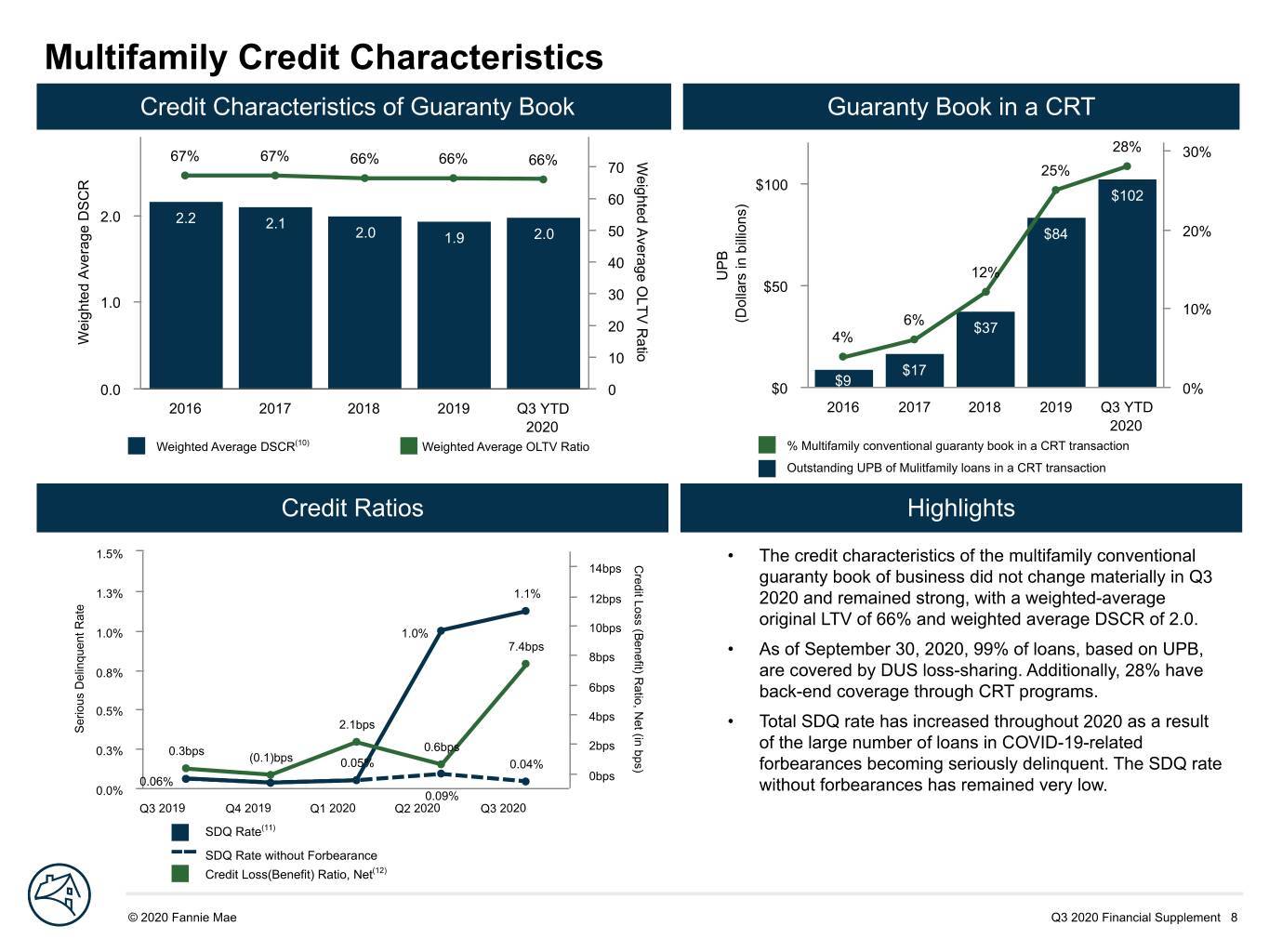
DRAFT Multifamily Credit Characteristics Credit Characteristics of Guaranty Book Guaranty Book in a CRT 28% 30% 67% 67% 66% 66% 66% We ighted Average OLTV Ratio 70 25% $100 $102 60 2.0 2.2 2.1 2.0 1.9 2.0 50 $84 20% 40 12% UP B $50 30 1.0 10% (D ollars in billions) 6% 20 $37 We ighted Average DSCR 4% 10 $17 $9 0.0 0 $0 0% 2016 2017 2018 2019 Q3 YTD 2016 2017 2018 2019 Q3 YTD 2020 2020 Weighted Average DSCR(10) Weighted Average OLTV Ratio % Multifamily conventional guaranty book in a CRT transaction Outstanding UPB of Mulitfamily loans in a CRT transaction Credit Ratios Highlights 1.5% • The credit characteristics of the multifamily conventional Cr edit Loss (Benefit) Ratio, Net (in bps) 14bps guaranty book of business did not change materially in Q3 1.3% 1.1% 12bps 2020 and remained strong, with a weighted-average original LTV of 66% and weighted average DSCR of 2.0. 1.0% 1.0% 10bps 7.4bps 8bps • As of September 30, 2020, 99% of loans, based on UPB, 0.8% are covered by DUS loss-sharing. Additionally, 28% have 6bps back-end coverage through CRT programs. 0.5% 4bps 2.1bps • Total SDQ rate has increased throughout 2020 as a result Se rious Delinquent Rate 0.3% 0.3bps 0.6bps 2bps of the large number of loans in COVID-19-related (0.1)bps 0.05% 0.04% forbearances becoming seriously delinquent. The SDQ rate 0.06% 0bps 0.0% without forbearances has remained very low. 0.06% 0.09% Q3 2019 Q4 2019 Q1 2020 Q2 2020 Q3 2020 SDQ Rate(11) SDQ Rate without Forbearance Credit Loss(Benefit) Ratio, Net(12) © 2020 Fannie Mae Q3 2020 Financial Supplement 8
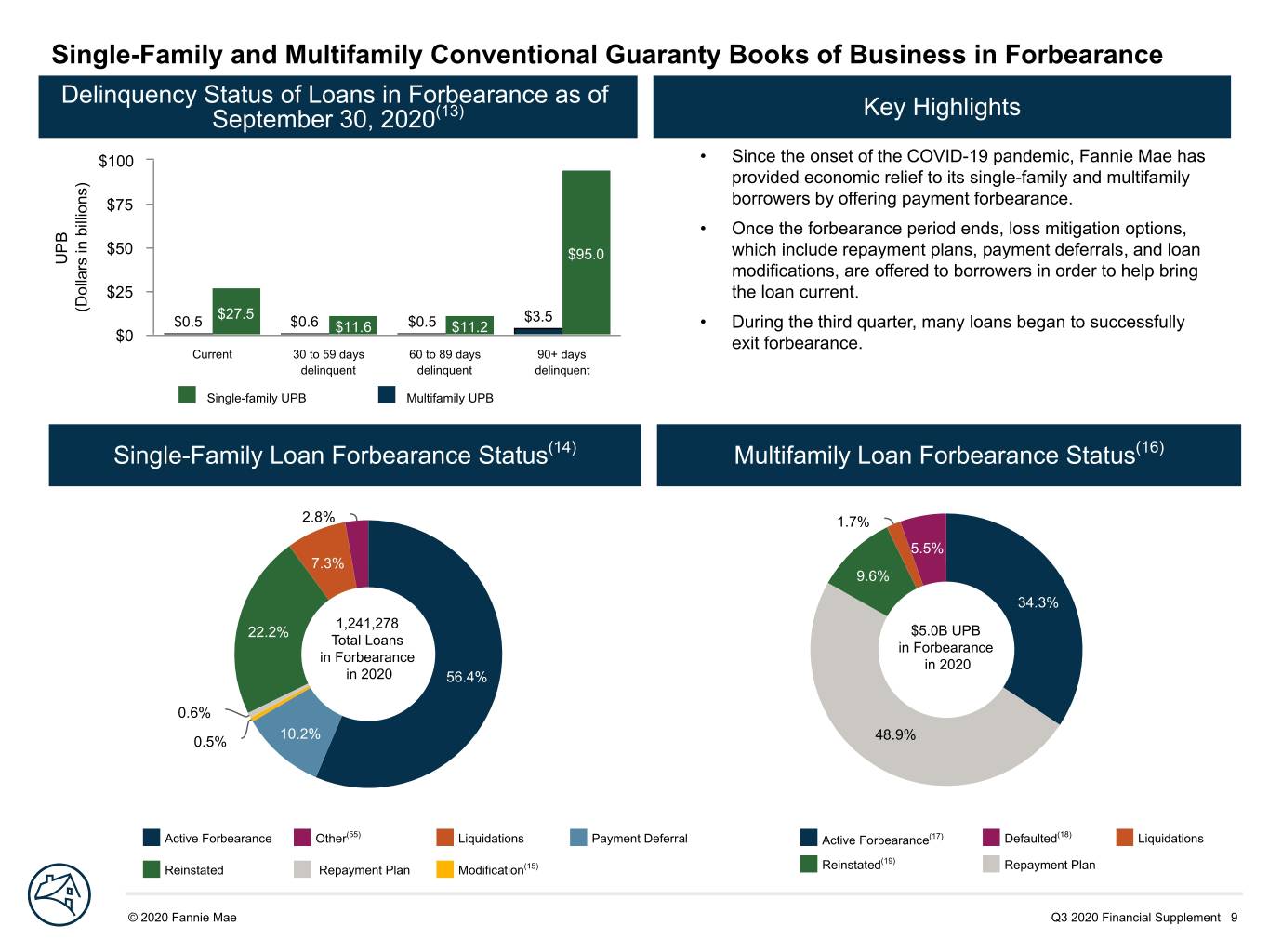
DRAFT Single-Family and Multifamily Conventional Guaranty Books of Business in Forbearance Delinquency Status of Loans in Forbearance as of September 30, 2020(13) Key Highlights $100 • Since the onset of the COVID-19 pandemic, Fannie Mae has provided economic relief to its single-family and multifamily $75 borrowers by offering payment forbearance. • Once the forbearance period ends, loss mitigation options, $50 $95.0 which include repayment plans, payment deferrals, and loan UP B modifications, are offered to borrowers in order to help bring $25 the loan current. (D ollars in billions) $27.5 $3.5 $0.5 $0.6 $11.6 $0.5 $11.2 • During the third quarter, many loans began to successfully $0 exit forbearance. Current 30 to 59 days 60 to 89 days 90+ days delinquent delinquent delinquent Single-family UPB Multifamily UPB Single-Family Loan Forbearance Status(14) Multifamily Loan Forbearance Status(16) 2.8% 1.7% 5.5% 7.3% 9.6% 34.3% 1,241,278 22.2% $5.0B UPB Total Loans in Forbearance in Forbearance in 2020 in 2020 56.4% 0.6% 10.2% 0.5% 48.9% Active Forbearance Other(55) Liquidations Payment Deferral Active Forbearance(17) Defaulted(18) Liquidations (19) Reinstated Repayment Plan Modification(15) Reinstated Repayment Plan © 2020 Fannie Mae Q3 2020 Financial Supplement 9

Portfolio and Liquidity Management DRAFT Sources of Net Interest Income and Retained Mortgage Portfolio Balance Key Highlights 100% $600 8% • The COVID-19 pandemic and the relief the company is 21% 21% 15% Re tained Mortgage Portfolio 26% 92% offering impacted borrowers has increased its debt 85% (D ollars in billions) funding needs and activity. The company increased long- 75% 79% 79% 74% $400 term debt issuances significantly in 2020 due to increased whole loan conduit acquisitions, to pay off callable debt, in 50% preparation for new FHFA liquidity risk management requirements and in anticipation of potential future $272.4 $200 $230.8 liquidity needs, including loss mitigation activities and loan 25% % Net Interest Income buyouts from trust. $179.2 $172.1 $153.6 • Total outstanding debt UPB increased by 59% from December 31, 2019 to reach $290B at September 30, 0% $0 2016 2017 2018 2019 Q3 YTD 2020. 2020 • OIP balance has also increased significantly during 2020 (20) % Net interest income from guaranty book of business driven by proceeds from debt issuances and high levels (21) % Net interest income from portfolios of loan refinance activity. Retained mortgage portfolio, at end of period Debt of Fannie Mae(22) Other Investments Portfolio ("OIP") Treasury Debt Limit $200 $186.2 $300.0 $176.0 $289.9 $300 $276.2 $150 $133.0 $250 $229.1 $213.6 $96.0 $200 $182.3 $44.7 $136.0 $100 $81.8 $233.9 $74.3 $150 $170.7 $266.4 $177.7 $36.0 $25.5 $100 $155.6 $50 $39.5 (D ollars in billions) (D ollars in billions) $12.7 $23.2 $80.5 $50 $13.6 $54.5 $58.4 $37.5 $35.9 $26.7 $42.3 $22.6 $21.2 $23.5 $0 $0 Q3 2019 Q4 2019 Q1 2020 Q2 2020 Q3 2020 Q3 2019 Q4 2019 Q1 2020 Q2 2020 Q3 2020 Cash and cash equivalents(23) Short-term debt Federal funds sold and securities purchased under agreements to resell or similar arrangements Long-term debt U.S. Treasury securities © 2020 Fannie Mae Q3 2020 Financial Supplement 10

DRAFT Key Market Economic Indicators U.S. GDP Growth (Decline) Rate and Benchmark Interest Rates Unemployment Rate(25) 4.72% 7.9% 3.83% 10% 3.64% 4.7% 4.1% 3.9% 3.81% 3.5% 2.90% 5% 2.97% 2.61% 0% 3.06% 1.6% 2.4% 1.3% 2.4% 2.33% -5% (2.6)% 1.40% Ra te (as of period end) 1.66% -10% 0.68% 2016 2017 2018 2019 Q3 YTD 9/30/2017 9/30/2018 9/30/2019 9/30/2020 2020 (24) 30-year FRM rate 10-year Treasury rate 30-year Fannie Mae MBS par coupon rate Growth (decline) in GDP, annualized change U.S. unemployment rate (26) One Year Home Price Growth Rate Q3 2020 (26) United States 7.3% Single-Family Home Price Growth Rate 8% 7.0% 5.8% 6% 5.3% 5.2% 4.5% 4% 2% Ho me Price Growth 0% 2016 2017 2018 2019 Q3 YTD 2020 Top 10 States by UPB(26) Share of Single- One Year Home Price Family Conventional State Growth Rate Q3 2020 Guaranty Book CA 6.94% 19.0% TX 5.23% 6.6% FL 6.74% 5.9% NY 6.40% 4.7% WA 10.49% 3.9% IL 4.88% 3.4% NJ 6.56% 3.4% CO 7.24% 3.3% State Growth Rate: 0.0 to 4.9% 5.0 to 9.9% 10% and above VA 7.40% 3.3% PA 6.67% 2.8% © 2020 Fannie Mae Q3 2020 Financial Supplement 11

DRAFT Net Worth, Treasury Funding and Senior Preferred Stock Dividends Net Worth and Treasury Funding Commitment Dividend Payments and Draws (Dollars in billions) (Dollars in billions) $181.4 $119.8 $113.9 $20.7 As of September 30, 2020 As of September 30, 2020 Net worth Cumulative dividend payments to Treasury(27) Remaining Treasury funding commitment Cumulative draws from Treasury(28) © 2020 Fannie Mae Q3 2020 Financial Supplement 12
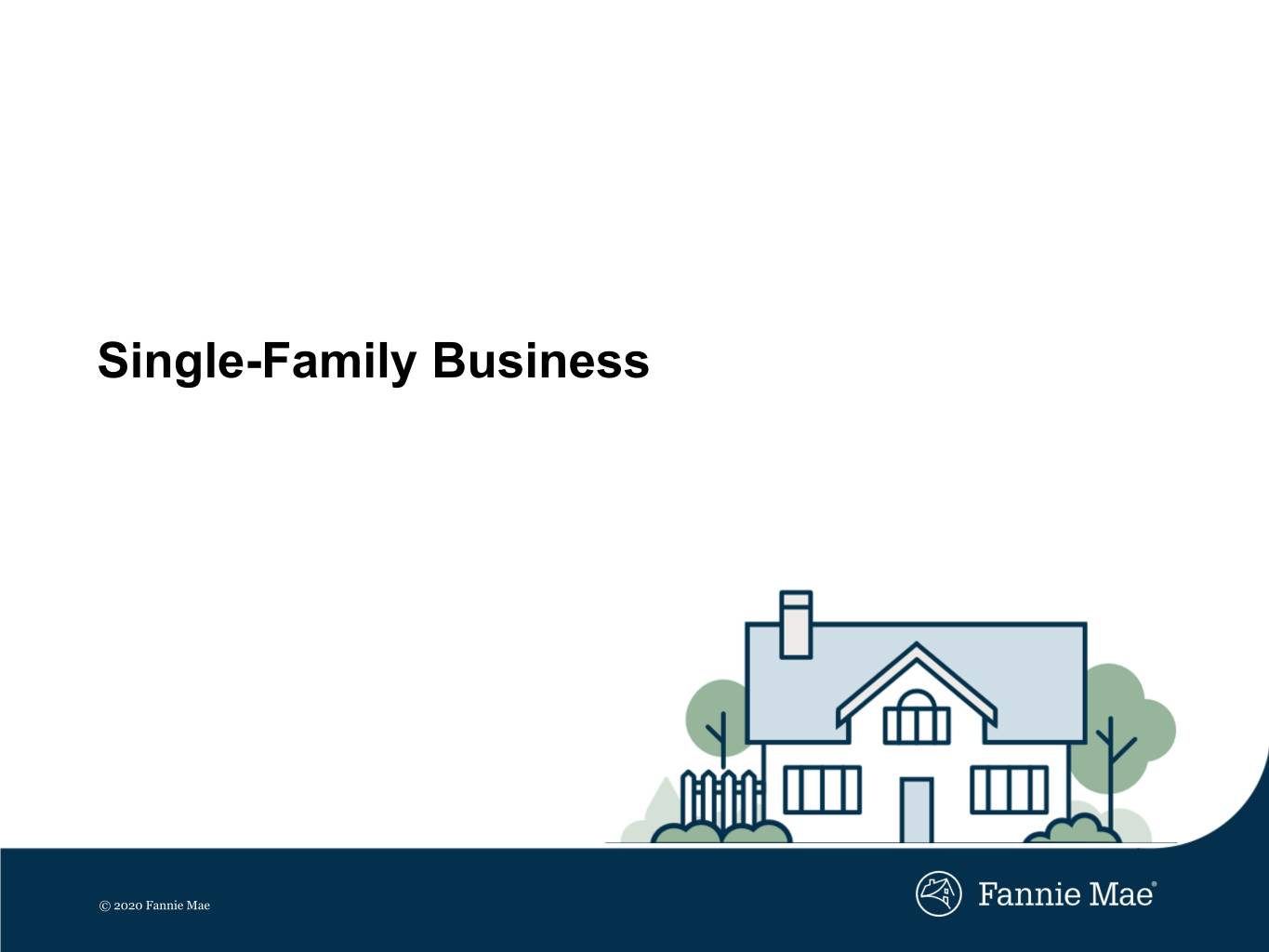
DRAFT Single-Family Business © 2020 Fannie Mae

Single-Family Highlights DRAFT Single-Family Conventional Loan Single-Family Conventional Guaranty Book Q3 2020 Acquisitions(2) of Business(2) $4,000 50 49.4 44.2 44.4 46.9 46.7 43.5 43.6 43.8 45.9 44.9 50 40 $5,870M $391 $3,000 Net interest income 40 $3,086 $400 $351 $2,924 $2,946 $2,964 $3,014 30 30 $2,000 UP B UP B $194 $266 $189 $191 20 $259 $200 20 (D ollars in billions) (D ollars in billions) $90 $1,000 $583M $116 $122 10 10 Investment gains, net $125 $104 $73 $69 $92 $0 0 $0 0 Q3 2019 Q4 2019 Q1 2020 Q2 2020 Q3 2020 Q3 2019 Q4 2019 Q1 2020 Q2 2020 Q3 2020 Refinance Average UPB outstanding of single-family conventional guaranty book Purchase Average charged guaranty fee on single-family conventional guaranty book, (4) Average charged guaranty fee on new single-family conventional acquisitions, net net of TCCA (bps) $(244)M of TCCA (bps)(4) Fair value losses, net New Single-Family Mortgage-Related Securities Share of Issuances Q3 2020 Key Highlights • The average single-family conventional guaranty book of $478M Private-label business during the third quarter of 2020 increased from the Credit-related securities second quarter of 2020 by approximately $72 billion to $3.1 income 2% trillion. Ginnie Mae • Single-family serious delinquency rate increased to 3.20% as 23% of September 30, 2020 from 2.65% as of June 30, 2020, as a Fannie Mae result of the large number of loans in COVID-19-related 41% forbearances becoming seriously delinquent. The single-family serious delinquency rate excluding loans in forbearance was $3,769M 0.65% as of September 30, 2020. Net income • As of September 30, 2020, 4.1% of Fannie Mae’s single-family guaranty book of business based on loan count was in forbearance, the vast majority of which was related to Freddie Mac COVID-19, compared to 5.7% as of June 30, 2020. As of 34% September 30, 2020, 20% of the loans in forbearance were still current. © 2020 Fannie Mae Q3 2020 Financial Supplement 14
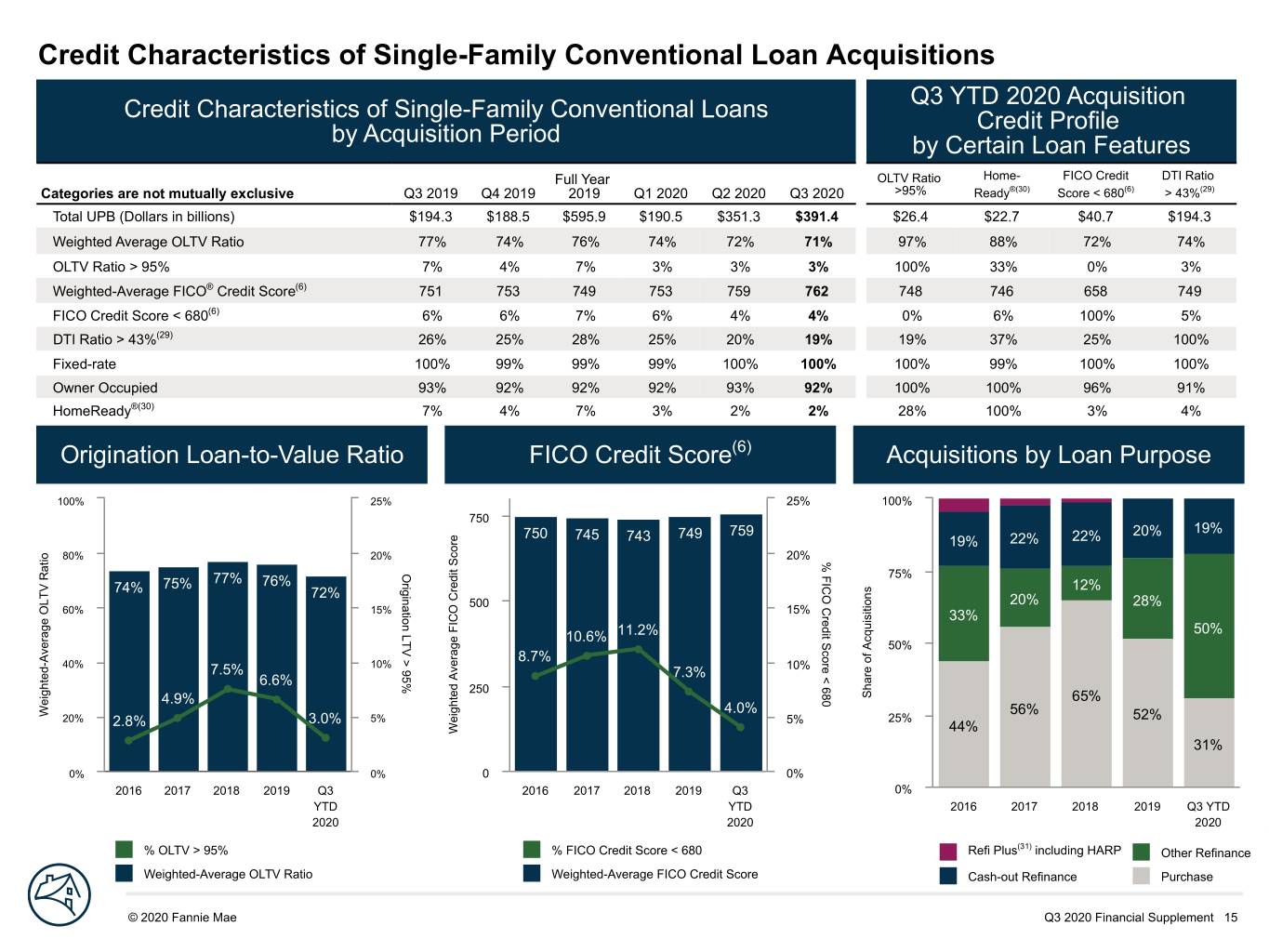
DRAFT Credit Characteristics of Single-Family Conventional Loan Acquisitions Q3 YTD 2020 Acquisition Credit Characteristics of Single-Family Conventional Loans Credit Profile by Acquisition Period by Certain Loan Features Full Year OLTV Ratio Home- FICO Credit DTI Ratio Categories are not mutually exclusive Q3 2019 Q4 2019 2019 Q1 2020 Q2 2020 Q3 2020 >95% Ready®(30) Score < 680(6) > 43%(29) Total UPB (Dollars in billions) $194.3 $188.5 $595.9 $190.5 $351.3 $391.4 $26.4 $22.7 $40.7 $194.3 Weighted Average OLTV Ratio 77% 74% 76% 74% 72% 71% 97% 88% 72% 74% OLTV Ratio > 95% 7% 4% 7% 3% 3% 3% 100% 33% 0% 3% Weighted-Average FICO® Credit Score(6) 751 753 749 753 759 762 748 746 658 749 FICO Credit Score < 680(6) 6% 6% 7% 6% 4% 4% 0% 6% 100% 5% DTI Ratio > 43%(29) 26% 25% 28% 25% 20% 19% 19% 37% 25% 100% Fixed-rate 100% 99% 99% 99% 100% 100% 100% 99% 100% 100% Owner Occupied 93% 92% 92% 92% 93% 92% 100% 100% 96% 91% HomeReady®(30) 7% 4% 7% 3% 2% 2% 28% 100% 3% 4% Origination Loan-to-Value Ratio FICO Credit Score(6) Acquisitions by Loan Purpose 100% 25% 25% 100% 750 750 749 759 20% 19% 745 743 19% 22% 22% 80% 20% 20% % FICO Credit Score < 680 Or igination LTV > 95% 75% 75% 77% 76% 12% 74% 72% 500 20% 28% 60% 15% 15% 33% 50% 10.6% 11.2% 50% 8.7% 40% 10% 7.5% 7.3% 10% 6.6% 250 4.9% Sh are of Acquisitions 65% 4.0% We ighted-Average OLTV Ratio 56% 52% 20% 2.8% 3.0% 5% 5% 25% We ighted Average FICO Credit Score 44% 31% 0% 0% 0 0% 2016 2017 2018 2019 Q3 2016 2017 2018 2019 Q3 0% YTD YTD 2016 2017 2018 2019 Q3 YTD 2020 2020 2020 (31) % OLTV > 95% % FICO Credit Score < 680 Refi Plus including HARP Other Refinance Weighted-Average OLTV Ratio Weighted-Average FICO Credit Score Cash-out Refinance Purchase © 2020 Fannie Mae Q3 2020 Financial Supplement 15

Credit Characteristics of Single-Family Conventional Guaranty Book of BusinessDRAFT Credit Characteristics of Single-Family Conventional Guaranty Book of Business by Origination Year and Loan Features(2)(32) As of September 30, 2020 Origination Year Certain Loan Features FICO Credit Refi Plus Overall 2004 & 2005- 2009- OLTV Home- Score < Including DTI Ratio ®(30) (6) (29) Categories are not mutually exclusive Book Earlier 2008 2016 2017 2018 2019 2020 Ratio > 95% Ready 680 HARP(31) > 43% Total UPB (Dollars in billions) $3,120.3 $55.4 $89.6 $1,247.9 $258.7 $208.8 $426.0 $833.9 $188.8 $89.5 $295.3 $234.4 $715.6 Average UPB $181,361 $67,196 $115,064 $149,247 $189,835 $193,903 $238,279 $276,753 $160,107 $179,139 $142,863 $121,230 $193,581 Share of Single-Family Conventional Guaranty Book 100% 2% 3% 40% 8% 7% 13% 27% 6% 3% 10% 8% 24% Loans in Forbearance by UPB 4.7% 8.2% 13.1% 4.6% 6.9% 9.0% 6.3% 1.1% 7.5% 7.5% 11.7% 6.2% 8.2% Share of Loans with Credit Enhancement(33) 45% 6% 15% 48% 68% 76% 55% 26% 77% 88% 43% 44% 48% Serious Delinquency Rate(8) 3.20% 5.81% 9.84% 2.76% 4.20% 5.44% 3.61% 0.53% 5.47% 4.73% 8.28% 3.76% 5.40% Weighted-Average OLTV Ratio 74% 74% 76% 75% 76% 78% 76% 72% 106% 89% 77% 86% 76% OLTV Ratio > 95% 6% 6% 10% 7% 6% 10% 7% 3% 100% 39% 11% 30% 8% Amortized OLTV Ratio(34) 67% 48% 62% 60% 69% 74% 74% 71% 95% 86% 69% 68% 69% Weighted-Average Mark-to-Market LTV Ratio(5) 57% 33% 54% 44% 59% 66% 70% 70% 74% 79% 57% 46% 60% Weighted-Average FICO Credit Score(6) 749 700 695 751 743 737 748 759 727 738 648 728 736 FICO Credit Score < 680(6) 10% 36% 39% 9% 12% 14% 8% 4% 17% 11% 100% 22% 14% (8) Mark-to-Market Loan-to-Value (6) SDQ Rate by Vintage (5) FICO Credit Score (MTMLTV) Ratio as of September 30, 2020 70% 10% 25% 100.00% 750 100% 95.35% 60% 745 745 746 746 749 9.84% 60% 20% FI CO Credit Score < 680 58% 57% 57% 10% 57% 7.5% % MTMLTV >100% 50% 75% 500 15% SD Q Rate 40% 12.2% 11.8% 11.4% 5.81% 5% 10.5% 9.5% 50% 30% 10% 5% 250 Bo ok of Business 3.20% 20% 2.74% 1.9% 2.5% We ighted Average MTMLTV 25% 5% 1.0% 10% % of UPB in Conventional Guaranty 0.5% We ighted Average FICO Credit Score 0.3% 0.1% 1.78% 2.87% 0 0% 0% 0% 0% 0% 2016 2017 2018 2019 Q3 2016 2017 2018 2019 Q3 Total 2004 2005- 2009- YTD YTD and 2008 2020 2020 2020 Prior % MTMLTV > 100% % FICO Credit Score < 680 SDQ Rate Weighted-Average MTMLTV Weighted-Average FICO Credit Score % of UPB in Conventional Guaranty Book of Business by Origination Year © 2020 Fannie Mae Q3 2020 Financial Supplement 16

DRAFT Single-Family Credit Risk Transfer Single-Family Credit Risk Transfer Single-Family Loans with Credit Enhancement $1,750 46% 46% 2018 2019 Q3 YTD 2020 $1,500 41% 40% 35% 40% Credit Enhancement Outstanding % of Book(35) Outstanding % of Book(35) Outstanding % of Book(35) $1,250 $1,341 $1,371 Outstanding UPB (dollars in billions) UPB Outstanding UPB Outstanding UPB Outstanding $1,213 $1,224 Primary mortgage insurance & (36) $618 21% $653 22% $674 21% $1,000 $1,067 other UP B $750 Connecticut Avenue Securities(37) $798 27% $919 31% $708 23% 20% (D ollars in billions) Credit Insurance Risk $500 $243 8% $275 10% $246 8% Transfer(7) $250 Lender risk-sharing(37) $102 4% $147 5% $113 4% $0 0% (Less: loans covered by multiple ($394) (13)% ($438) (15)% ($338) (11)% Q3 2019 Q4 2019 Q1 2020 Q2 2020 Q3 2020 credit enhancements) % Single-family conventional guaranty book in a CRT transaction Total single-family loans with $1,367 47% $1,556 53% $1,403 45% Outstanding UPB of single-family loans in a CRT transaction(7) credit enhancement Single-Family Credit Risk Transfer Issuance $600 $445 $410 $400 $73 $331 $44 $338 $15 $45 UP B $233 $239 $265 $290 $200 (D ollars in billions) $240 $206 $133 $222 $189 $14 $58 $76 $102 $86 $82 $40 $61 $0 2014 2015 2016 2017 2018 2019 Q3 YTD 2020 Lender risk-sharing Connecticut Avenue Securities Credit Insurance Risk Transfer © 2020 Fannie Mae Q3 2020 Financial Supplement 17
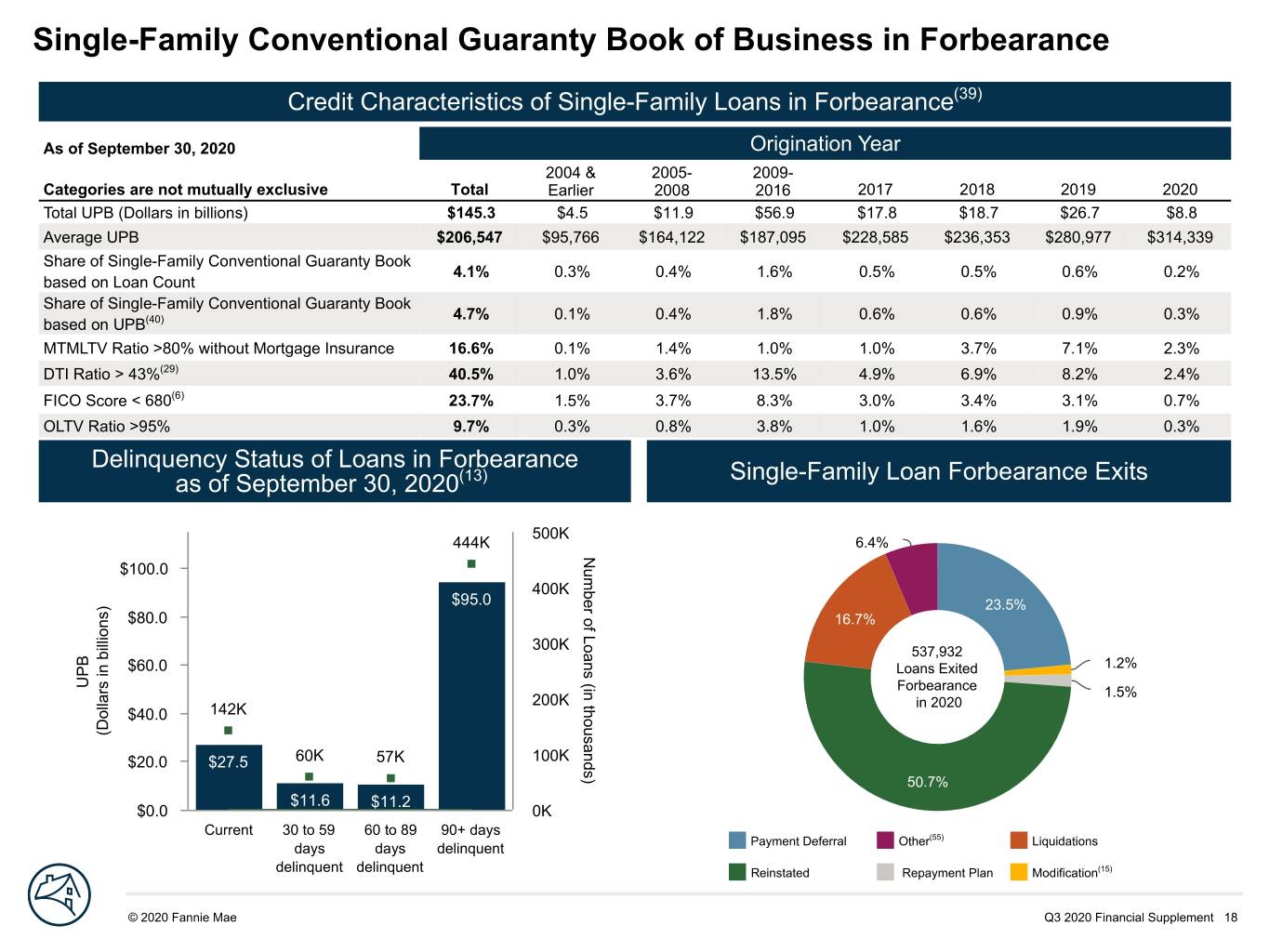
Single-Family Conventional Guaranty Book of Business in ForbearanceDRAFT Credit Characteristics of Single-Family Loans in Forbearance(39) As of September 30, 2020 Origination Year 2004 & 2005- 2009- Categories are not mutually exclusive Total Earlier 2008 2016 2017 2018 2019 2020 Total UPB (Dollars in billions) $145.3 $4.5 $11.9 $56.9 $17.8 $18.7 $26.7 $8.8 Average UPB $206,547 $95,766 $164,122 $187,095 $228,585 $236,353 $280,977 $314,339 Share of Single-Family Conventional Guaranty Book 4.1% 0.3% 0.4% 1.6% 0.5% 0.5% 0.6% 0.2% based on Loan Count Share of Single-Family Conventional Guaranty Book 4.7% 0.1% 0.4% 1.8% 0.6% 0.6% 0.9% 0.3% based on UPB(40) MTMLTV Ratio >80% without Mortgage Insurance 16.6% 0.1% 1.4% 1.0% 1.0% 3.7% 7.1% 2.3% DTI Ratio > 43%(29) 40.5% 1.0% 3.6% 13.5% 4.9% 6.9% 8.2% 2.4% FICO Score < 680(6) 23.7% 1.5% 3.7% 8.3% 3.0% 3.4% 3.1% 0.7% OLTV Ratio >95% 9.7% 0.3% 0.8% 3.8% 1.0% 1.6% 1.9% 0.3% Delinquency Status of Loans in Forbearance as of September 30, 2020(13) Single-Family Loan Forbearance Exits 500K 444K 6.4% Nu mber of Loans (in thousands) $100.0 400K $95.0 23.5% $80.0 16.7% 300K 537,932 $60.0 Loans Exited 1.2% UP B Forbearance 1.5% 200K in 2020 $40.0 142K (D ollars in billions) $20.0 $27.5 60K 57K 100K 50.7% $11.6 $11.2 $0.0 0K Current 30 to 59 60 to 89 90+ days Payment Deferral Other(55) Liquidations days days delinquent delinquent delinquent Reinstated Repayment Plan Modification(15) © 2020 Fannie Mae Q3 2020 Financial Supplement 18
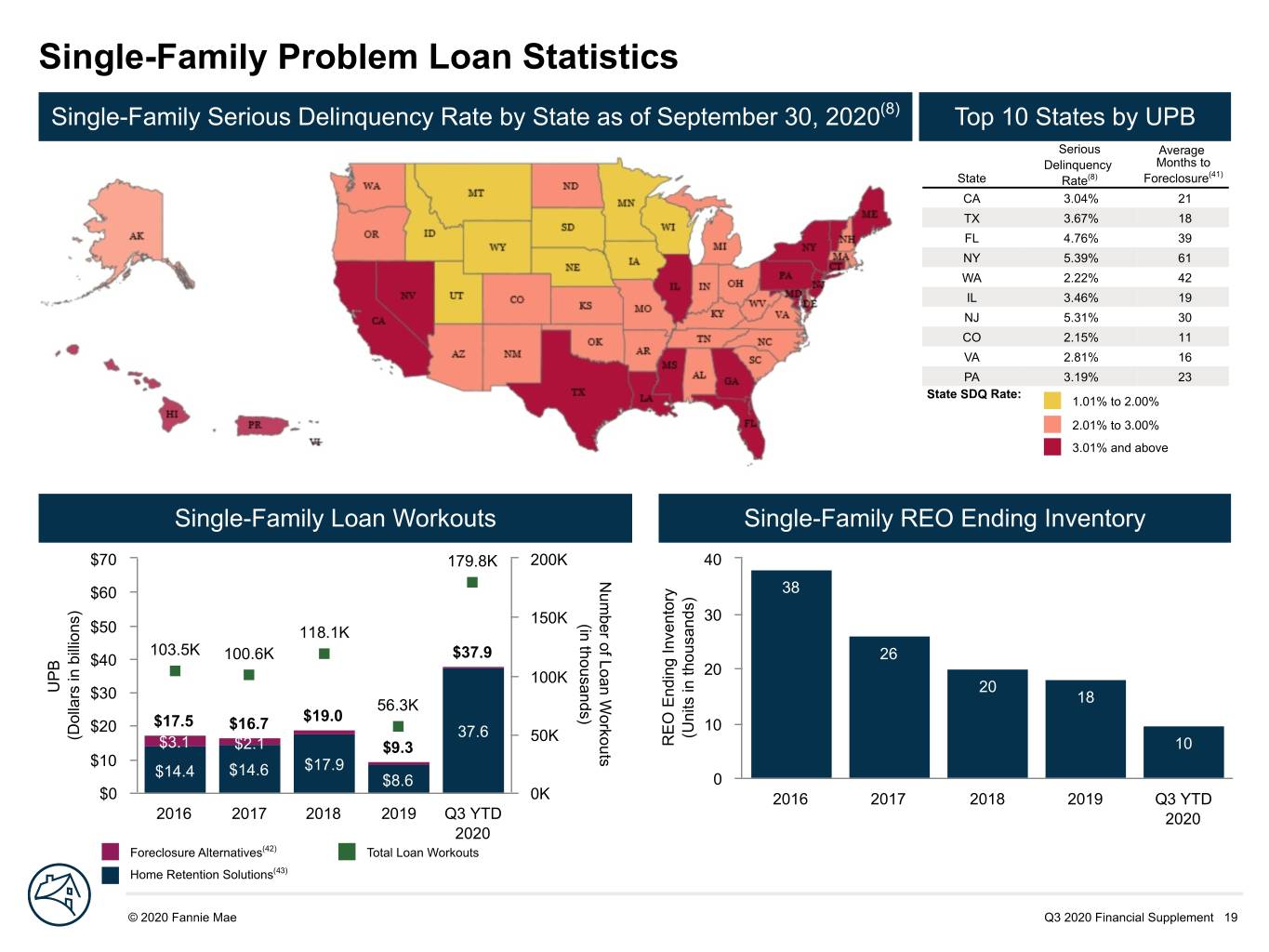
DRAFT Single-Family Problem Loan Statistics Single-Family Serious Delinquency Rate by State as of September 30, 2020(8) Top 10 States by UPB Serious Average Delinquency Months to (41) State Rate(8) Foreclosure CA 3.04% 21 TX 3.67% 18 FL 4.76% 39 NY 5.39% 61 WA 2.22% 42 IL 3.46% 19 NJ 5.31% 30 CO 2.15% 11 VA 2.81% 16 PA 3.19% 23 State SDQ Rate: 1.01% to 2.00% 2.01% to 3.00% 3.01% and above Single-Family Loan Workouts Single-Family REO Ending Inventory $70 179.8K 200K 40 Nu mber of Loan Workouts $60 38 150K (i n thousands) 30 $50 118.1K 103.5K $40 100.6K $37.9 26 100K 20 UP B $30 20 56.3K 18 $17.5 $19.0 $20 $16.7 10 (U nits in thousands) (D ollars in billions) 37.6 50K RE O Ending Inventory $3.1 $2.1 $9.3 10 $10 $14.4 $14.6 $17.9 $8.6 0 $0 0K 2016 2017 2018 2019 Q3 YTD 2016 2017 2018 2019 Q3 YTD 2020 2020 Foreclosure Alternatives(42) Total Loan Workouts Home Retention Solutions(43) © 2020 Fannie Mae Q3 2020 Financial Supplement 19

DRAFT Credit Loss Concentration of Single-Family Conventional Guaranty Book of Business (44) % of Single-Family Conventional Guaranty Book of Business(35) % of Single-Family Credit Losses For the Period Ended Certain Product Features Q3 YTD Q3 YTD Categories are not mutually exclusive 2016 2017 2018 2019 2020 2016 2017 2018 2019 2020 Credit losses by period (Dollars in millions) $3,338 $2,963 $2,457 $1,719 $505 100.0% 100.0% 100.0% 100.0% 100.0% Alt-A(45) 3.1% 2.5% 1.9% 1.5% 1.2% 24.9% 21.9% 22.4% 16.6% 16.7% Interest-only 1.7% 1.2% 0.8% 0.5% 0.4% 12.2% 15.7% 15.4% 11.5% 10.1% Origination LTV Ratio >95% 6.9% 6.6% 6.8% 6.9% 6.1% 15.2% 16.9% 14.9% 16.0% 14.1% FICO Credit Score < 680 and OLTV Ratio > 95%(6) 1.7% 1.6% 1.4% 1.3% 1.0% 8.1% 8.7% 8.7% 9.4% 8.9% FICO Credit Score < 680(6) 12.2% 11.8% 11.4% 10.5% 9.5% 48.7% 45.4% 46.3% 43.1% 43.0% Refi Plus including HARP 15.4% 13.2% 11.4% 9.5% 7.5% 14.0% 15.9% 13.2% 15.8% 15.5% Q3 YTD Q3 YTD Vintage 2016 2017 2018 2019 2020 2016 2017 2018 2019 2020 2009 - 2020 87% 90% 92% 94% 95% 19% 23% 20% 27% 30% 2005 - 2008 8% 6% 5% 4% 3% 65% 65% 66% 61% 59% 2004 & Prior 5% 4% 3% 2% 2% 16% 12% 14% 12% 11% % of Q3 YTD 2020 Single-Family % of Single-Family Conventional Guaranty Book of Credit Losses by State (44)(46) Business by State as of September 30, 2020 3.4% 5.9% 8.6% 3.4% 9.2% 4.7% 13.0% $505M $3.1T UPB 54.4% 19.0% 63.6% 7.8% 7.0% All Other States New York New Jersey All Other States New York New Jersey California Illinois Florida California Illinois Florida © 2020 Fannie Mae Q3 2020 Financial Supplement 20

DRAFT Single-Family Cumulative Default Rates Cumulative Default Rates of Single-Family Conventional Guaranty Book of Business by Origination Year(47) 2007 16% 2006 14% 12% 10% 2005 8% 2008 6% Cu mulative Default Rate 2004 4% 2% 2012 2011 2010 2009 0% Yr 1 Yr 3 Yr 5 Yr 7 Yr 9 Yr 2 Yr 4 Yr 6 Yr 8 Yr 10 Yr 12 Yr 14 Yr 11 Yr 13 Yr 15 Yr 17 Yr 16 Time Since Beginning of Origination Year 2004 2005 2006 2007 2008 2009* 2010* 2011* 2012* 2013* 2014* 2015* 2016* 2017* 2018* 2019* 2020* * As of September 30, 2020, cumulative default rates on the loans originated in each individual year from 2009-2020 were less than 1% © 2020 Fannie Mae Q3 2020 Financial Supplement 21
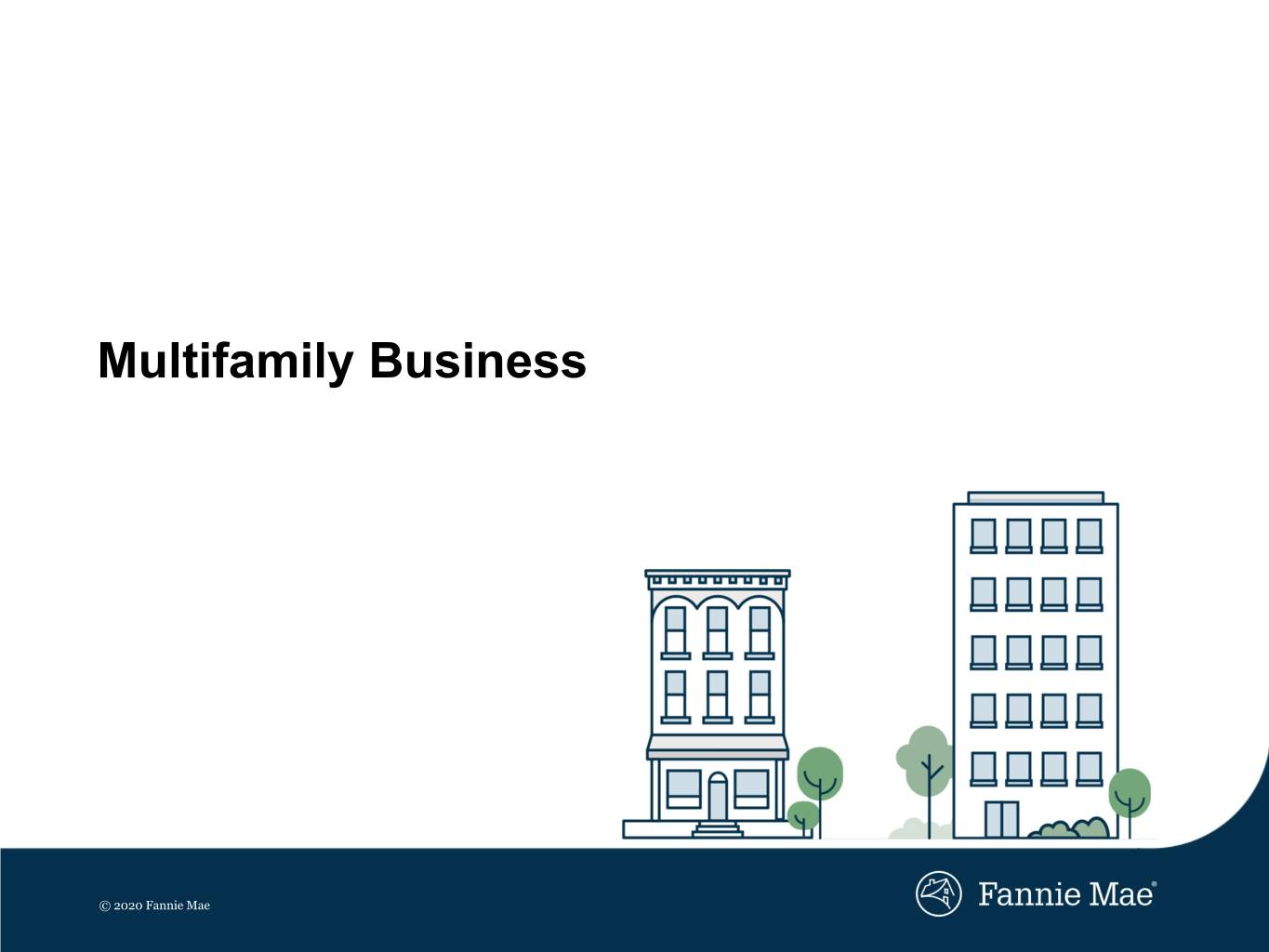
DRAFT Multifamily Business © 2020 Fannie Mae
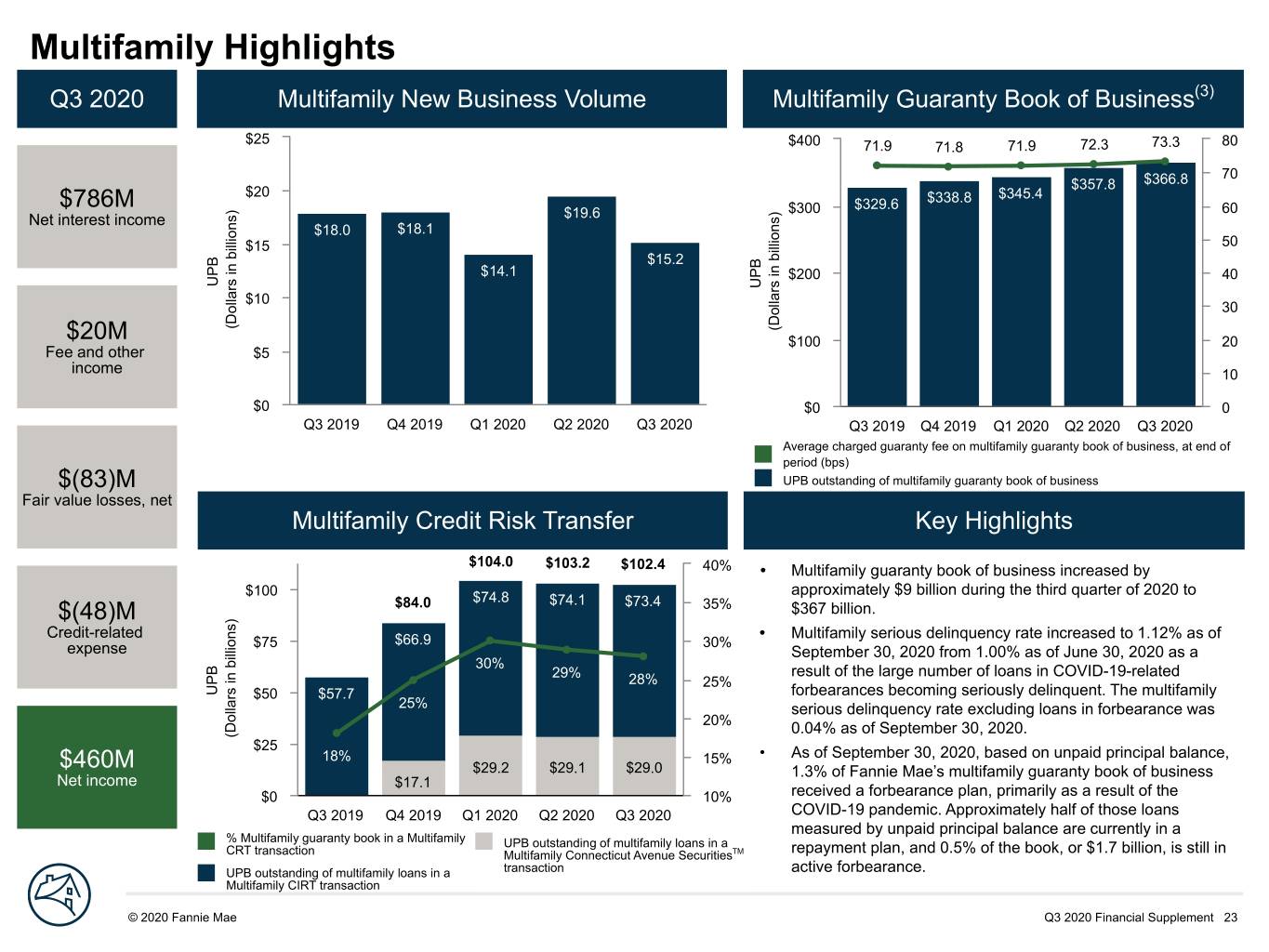
Multifamily Highlights DRAFT Q3 2020 Multifamily New Business Volume Multifamily Guaranty Book of Business(3) $25 $400 71.9 71.8 71.9 72.3 73.3 80 70 $357.8 $366.8 $20 $345.4 $786M $329.6 $338.8 $300 60 Net interest income $19.6 $18.0 $18.1 $15 50 $15.2 $14.1 $200 40 UP B UP B $10 30 (D ollars in billions) $20M (D ollars in billions) $100 20 Fee and other $5 income 10 $0 $0 0 Q3 2019 Q4 2019 Q1 2020 Q2 2020 Q3 2020 Q3 2019 Q4 2019 Q1 2020 Q2 2020 Q3 2020 Average charged guaranty fee on multifamily guaranty book of business, at end of period (bps) $(83)M UPB outstanding of multifamily guaranty book of business Fair value losses, net Multifamily Credit Risk Transfer Key Highlights $104.0 $103.2 $102.4 40% • Multifamily guaranty book of business increased by $100 approximately $9 billion during the third quarter of 2020 to $74.8 $74.1 $(48)M $84.0 $73.4 35% $367 billion. Credit-related • Multifamily serious delinquency rate increased to 1.12% as of $75 $66.9 30% expense September 30, 2020 from 1.00% as of June 30, 2020 as a 30% 29% result of the large number of loans in COVID-19-related 28% 25% UP B $50 $57.7 forbearances becoming seriously delinquent. The multifamily 25% serious delinquency rate excluding loans in forbearance was 20% 0.04% as of September 30, 2020. (D ollars in billions) $25 18% 15% • As of September 30, 2020, based on unpaid principal balance, $460M $29.2 $29.1 $29.0 1.3% of Fannie Mae’s multifamily guaranty book of business Net income 0 $17.1 received a forbearance plan, primarily as a result of the $0 10% Q3 2019 Q4 2019 Q1 2020 Q2 2020 Q3 2020 COVID-19 pandemic. Approximately half of those loans measured by unpaid principal balance are currently in a % Multifamily guaranty book in a Multifamily UPB outstanding of multifamily loans in a CRT transaction Multifamily Connecticut Avenue SecuritiesTM repayment plan, and 0.5% of the book, or $1.7 billion, is still in UPB outstanding of multifamily loans in a transaction active forbearance. Multifamily CIRT transaction © 2020 Fannie Mae Q3 2020 Financial Supplement 23
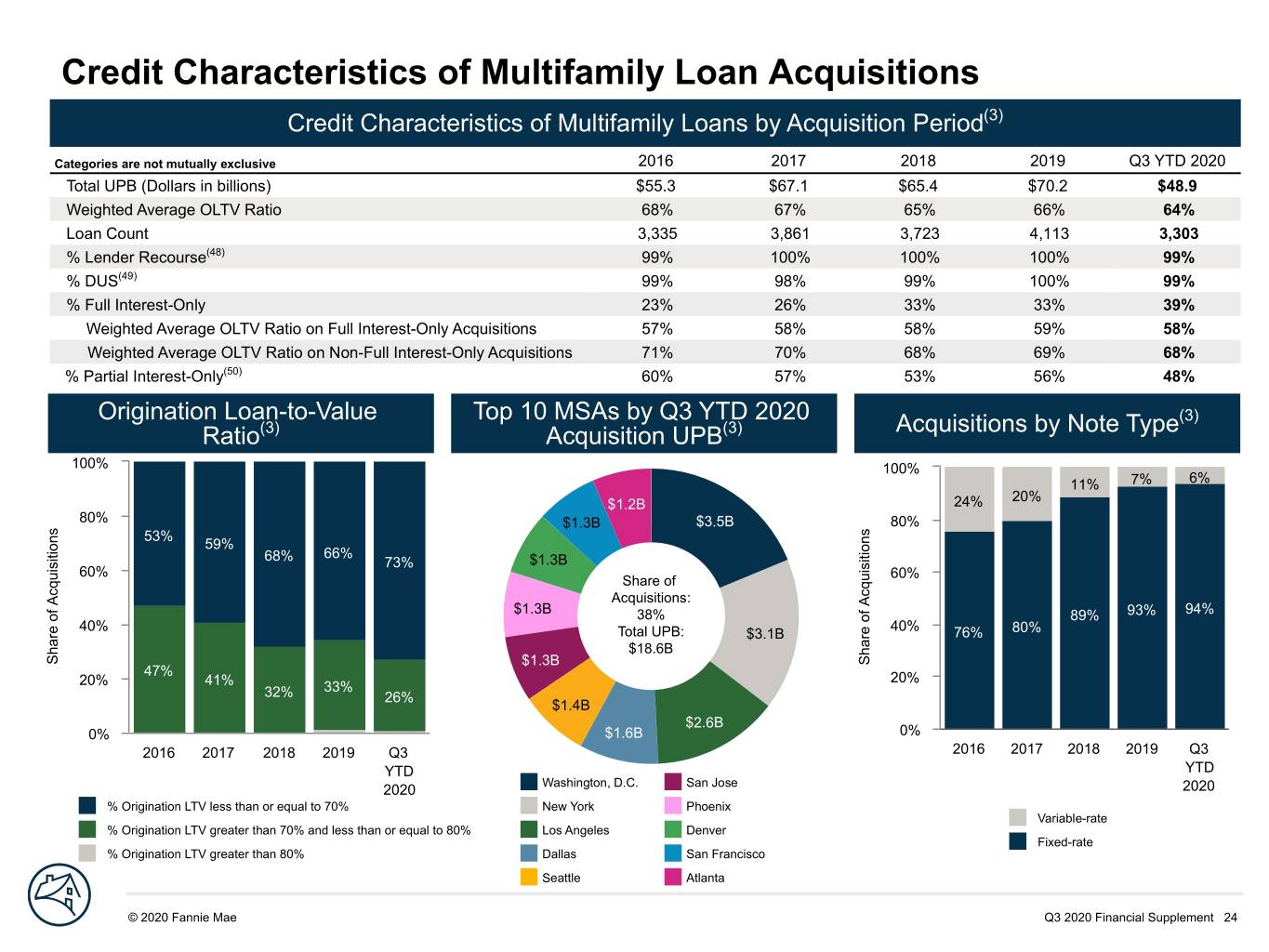
DRAFT Credit Characteristics of Multifamily Loan Acquisitions Credit Characteristics of Multifamily Loans by Acquisition Period(3) Categories are not mutually exclusive 2016 2017 2018 2019 Q3 YTD 2020 Total UPB (Dollars in billions) $55.3 $67.1 $65.4 $70.2 $48.9 Weighted Average OLTV Ratio 68% 67% 65% 66% 64% Loan Count 3,335 3,861 3,723 4,113 3,303 % Lender Recourse(48) 99% 100% 100% 100% 99% % DUS(49) 99% 98% 99% 100% 99% % Full Interest-Only 23% 26% 33% 33% 39% Weighted Average OLTV Ratio on Full Interest-Only Acquisitions 57% 58% 58% 59% 58% Weighted Average OLTV Ratio on Non-Full Interest-Only Acquisitions 71% 70% 68% 69% 68% % Partial Interest-Only(50) 60% 57% 53% 56% 48% Origination Loan-to-Value Top 10 MSAs by Q3 YTD 2020 (3) Ratio(3) Acquisition UPB(3) Acquisitions by Note Type 100% 100% 11% 7% 6% 20% $1.2B 24% 80% $1.3B $3.5B 80% 53% 59% 66% 68% 73% $1.3B 60% 60% Share of Acquisitions: $1.3B 38% 89% 93% 94% 40% 40% Total UPB: $3.1B 76% 80% $18.6B Sh are of Acquisitions $1.3B Sh are of Acquisitions 47% 20% 20% 41% 33% 32% 26% $1.4B $2.6B 0% 0% $1.6B 2016 2017 2018 2019 Q3 2016 2017 2018 2019 Q3 YTD YTD Washington, D.C. San Jose 2020 2020 % Origination LTV less than or equal to 70% New York Phoenix Variable-rate % Origination LTV greater than 70% and less than or equal to 80% Los Angeles Denver Fixed-rate % Origination LTV greater than 80% Dallas San Francisco Seattle Atlanta © 2020 Fannie Mae Q3 2020 Financial Supplement 24

DRAFT Credit Characteristics of Multifamily Guaranty Book of Business Credit Characteristics of Multifamily Guaranty Book of Business by Acquisition Year, Asset Class, or Targeted Affordable Segment(3) As of September 30, 2020 Acquisition Year Asset Class or Targeted Affordable Segment Overall 2004 & Conventional Seniors Student Manufactured Privately Owned Categories are not mutually exclusive Book Earlier 2005-2008 2009-2016 2017 2018 2019 2020 /Co-op(51) Housing(51) Housing(51) Housing(51) with Subsidy(52) Total UPB (Dollars in billions) $366.8 $3.8 $5.7 $117.3 $58.6 $62.7 $69.8 $48.9 $319.7 $17.3 $14.4 $15.4 $36.5 % of Multifamily Book 100% 1% 2% 32% 16% 17% 19% 13% 87% 5% 4% 4% 10% Loan Count 27,928 691 2,962 10,091 3,268 3,527 4,086 3,303 25,205 690 683 1,350 3,591 Average UPB (Dollars in millions) $13.1 $5.5 $1.9 $11.6 $17.9 $17.8 $17.1 $14.8 $12.7 $25.0 $21.0 $11.4 $10.2 Loans in Forbearance by UPB(38) 0.5% 0.1% 0.5% 0.4% 1.6% 0.1% 0.2% 0.0% 0.2% 3.4% 2.7% 0.0% 0.1% Weighted Average OLTV Ratio 66% 72% 66% 67% 67% 65% 66% 64% 66% 66% 67% 66% 69% Weighted Average DSCR(10) 2.0 3.1 2.4 2.0 2.0 1.8 1.9 2.2 2.0 1.8 1.8 2.0 2.1 % Fixed rate 90% 11% 42% 91% 87% 91% 93% 94% 91% 64% 86% 92% 77% % Full Interest-Only 29% 33% 25% 21% 29% 34% 33% 39% 31% 12% 24% 23% 20% % Partial Interest-Only(50) 51% 8% 23% 49% 56% 53% 56% 48% 50% 56% 66% 57% 41% % Small Balance Loans(53) 46% 74% 92% 50% 31% 28% 35% 37% 47% 14% 26% 51% 54% % DUS(3) 99% 97% 85% 99% 98% 100% 100% 99% 99% 98% 100% 100% 98% Serious Delinquency Rate(11) 1.12% 0.10% 0.92% 1.55% 2.67% 0.59% 0.38% 0.10% 0.56% 10.85% 3.06% 0.00% 0.27% UPB by Maturity Year(3) Top 10 MSAs by UPB(3) Top 5 MSAs by Forbearance UPB(38) $0.6B $9.1B $6.5B $9.4B $31.4B $76M $12.6B $9.6B $15.3B Share of Book Share of of Business: Forbearance: $82M $226M Total UPB: $18.8B $9.7B 40% 33% $366.8B Total Top 10 Total Top 5 UPB: Forbearance $10.9B $22.7B $146.5B UPB: $313.0B $0.6B $11.0B $87M $16.6B $16.1B $91M New York Atlanta New York Philadelphia Los Angeles Phoenix 2020 2023 Houston Cleveland Dallas Seattle 2021 2024 Dallas Washington, D.C. San Francisco 2022 Other Houston Chicago © 2020 Fannie Mae Q3 2020 Financial Supplement 25
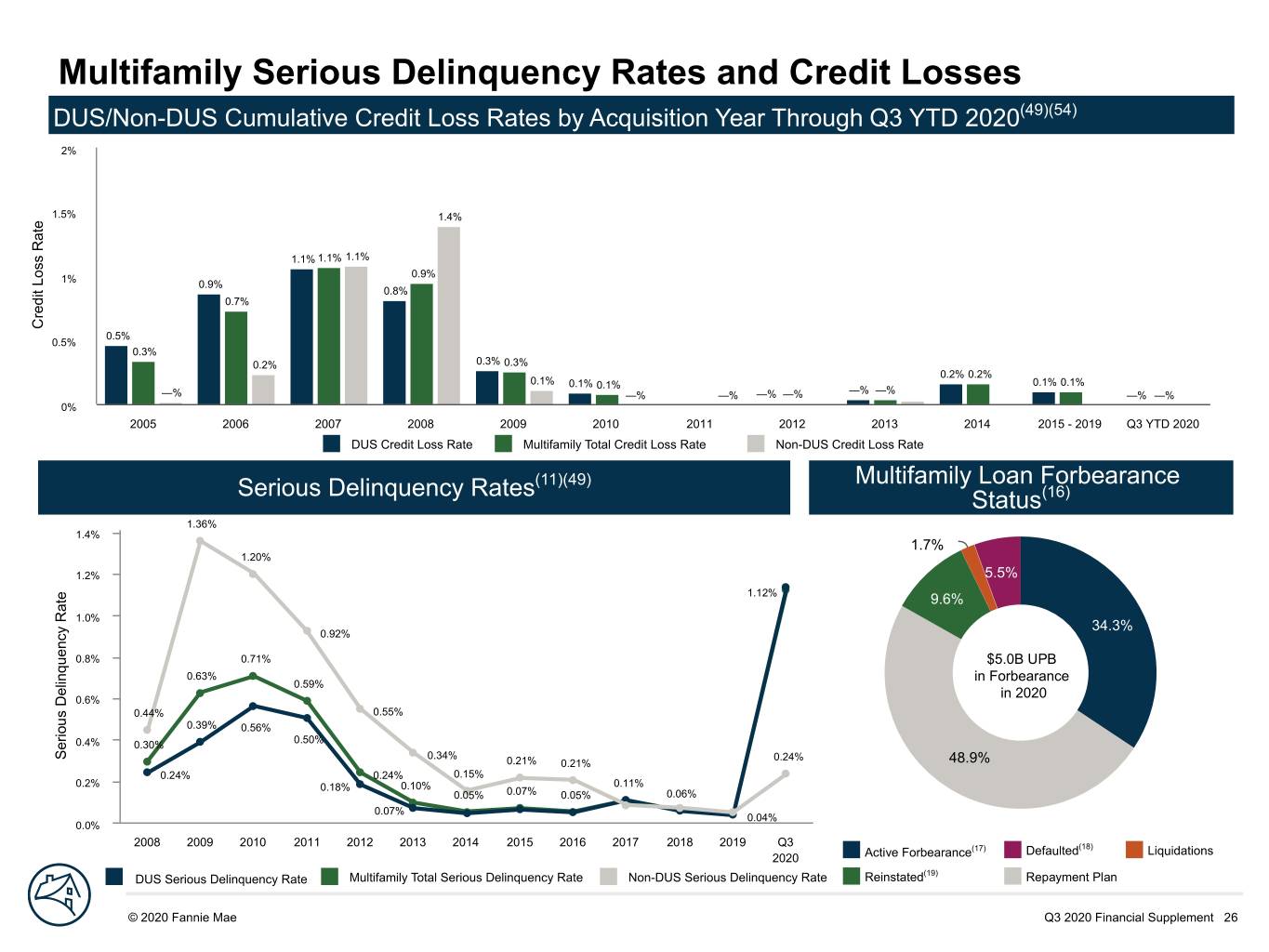
DRAFT Multifamily Serious Delinquency Rates and Credit Losses DUS/Non-DUS Cumulative Credit Loss Rates by Acquisition Year Through Q3 YTD 2020(49)(54) 2% 1.5% 1.4% 1.1% 1.1% 1.1% 0.9% 1% 0.9% 0.8% 0.7% Cr edit Loss Rate 0.5% 0.5% 0.3% 0.2% 0.3% 0.3% 0.2% 0.2% 0.1% 0.1% 0.1% 0.1% 0.1% —% —% —% —% —% —% —% —% —% 0% 2005 2006 2007 2008 2009 2010 —% 20—%11 2012 2013 2014 2015 - 2019 Q3 YTD 2020 DUS Credit Loss Rate Multifamily Total Credit Loss Rate Non-DUS Credit Loss Rate (11)(49) Multifamily Loan Forbearance Serious Delinquency Rates (16) Status 1.36% 1.4% 1.7% 1.20% 1.2% 5.5% 1.12% 9.6% 1.0% 34.3% 0.92% 0.8% 0.71% $5.0B UPB 0.63% in Forbearance 0.59% 0.6% in 2020 0.44% 0.55% 0.39% 0.56% 0.4% 0.30% 0.50% Se rious Delinquency Rate 0.34% 0.24% 0.21% 0.21% 48.9% 0.24% 0.24% 0.15% 0.2% 0.18% 0.10% 0.11% 0.05% 0.07% 0.05% 0.06% 0.07% 0.04% 0.0% 2008 2009 2010 2011 2012 2013 2014 2015 2016 2017 2018 2019 Q3 (17) Defaulted(18) Liquidations 2020 Active Forbearance (19) DUS Serious Delinquency Rate Multifamily Total Serious Delinquency Rate Non-DUS Serious Delinquency Rate Reinstated Repayment Plan © 2020 Fannie Mae Q3 2020 Financial Supplement 26

DRAFT Endnotes © 2020 Fannie Mae

DRAFT Endnotes (1) Prior period amounts have been adjusted to reflect the current year change in presentation related to yield maintenance fees. As of January 1, 2020, all yield maintenance fees have been reported in interest income. For consolidated loans, the portion of the fee passed through to the holders of the trust certificates are classified as interest expense. (2) Single-family conventional loan population consists of: (a) single-family conventional mortgage loans of Fannie Mae; (b) single-family conventional mortgage loans underlying Fannie Mae MBS other than loans underlying Freddie Mac securities that Fannie Mae has resecuritized; and (c) other credit enhancements that Fannie Mae provided on single- family mortgage assets, such as long-term standby commitments. It excludes non-Fannie Mae single-family mortgage-related securities held in the retained mortgage portfolio for which Fannie Mae does not provide a guaranty. Conventional refers to mortgage loans and mortgage-related securities that are not guaranteed or insured, in whole or in part, by the U.S. government or one of its agencies. (3) The multifamily guaranty book of business consists of: (a) multifamily mortgage loans of Fannie Mae; (b) multifamily mortgage loans underlying Fannie Mae MBS; and (c) other credit enhancements that the company provided on multifamily mortgage assets. It excludes non-Fannie Mae multifamily mortgage-related securities held in the retained mortgage portfolio for which Fannie Mae does not provide a guaranty. Data reflects the latest available information as of September 30, 2020. (4) Represents the sum of the average guaranty fee rate for the company's single-family conventional guaranty arrangements during the period plus the recognition of any upfront cash payments relating to these guaranty arrangements over an estimated average life at the time of acquisition. Excludes the impact of a 10 basis point guaranty fee increase implemented pursuant to the TCCA, the incremental revenue from which is remitted to Treasury and not retained by the company. (5) The average estimated mark-to-market LTV ratio is based on the unpaid principal balance of the loan divided by the estimated current value of the property at period end, which the company calculates using an internal valuation model that estimates periodic changes in home value. Excludes loans for which this information is not readily available. (6) FICO credit score is as of loan origination, as reported by the seller of the mortgage loan. (7) Includes mortgage pool insurance transactions covering loans with an unpaid principal balance of approximately $7 billion at issuance and approximately $2.5 billion outstanding as of September 30, 2020. (8) Single-family “serious delinquency rate" refers to single-family conventional loans that are 90 days or more past due or in the foreclosure process in the applicable origination year, product feature, or state, divided by the number of loans in the single-family conventional guaranty book of business in that origination year, product feature, or state. Loans in forbearance are reported as delinquent according to the contractual terms of the loans. (9) Basis points are calculated based on the amount of write-offs, recoveries and foreclosed property expenses annualized divided by the average single-family conventional guaranty book of business during the period. (10) Weighted average debt service coverage ratio, or DSCR, is calculated using the most recent property financial operating statements. When operating statement information is not available, the DSCR at the time of acquisition is used. If both are unavailable, the underwritten DSCR is used. Although the company uses the most recently available results from our multifamily borrowers, there is a lag in reporting, which typically can range from three to six months, but in some cases may be longer. Accordingly, the financial information we have received from borrowers may only reflect the initial impact of COVID-19. Co-op loans are excluded from this metric. (11) Multifamily loans are classified as seriously delinquent when payment is 60 days or more past due. (12) Credit loss (benefit) ratio, net represents the annualized net credit loss or benefit for the period divided by the average unpaid principal balance of the multifamily guaranty book of business for the period. Net credit benefits are the result of recoveries on previously charged-off amounts. Net credit losses include expected benefit of freestanding credit enhancements, primarily multifamily DUS lender-risk sharing transactions. (13) Pursuant to the Coronavirus Aid, Relief, and Economic Security Act (the "CARES Act"), for purposes of reporting to the credit bureaus, servicers must report a borrower receiving a COVID-19-related payment accommodation, such as a forbearance plan or loan modification, as current if the borrower was current prior to receiving the accommodation and the borrower makes all required payments in accordance with the accommodation. For purposes of the company's disclosures regarding delinquency status, loans receiving COVID-19-related payment forbearance are reported as delinquent according to the contractual terms of the loan. © 2020 Fannie Mae Q3 2020 Financial Supplement 28 .
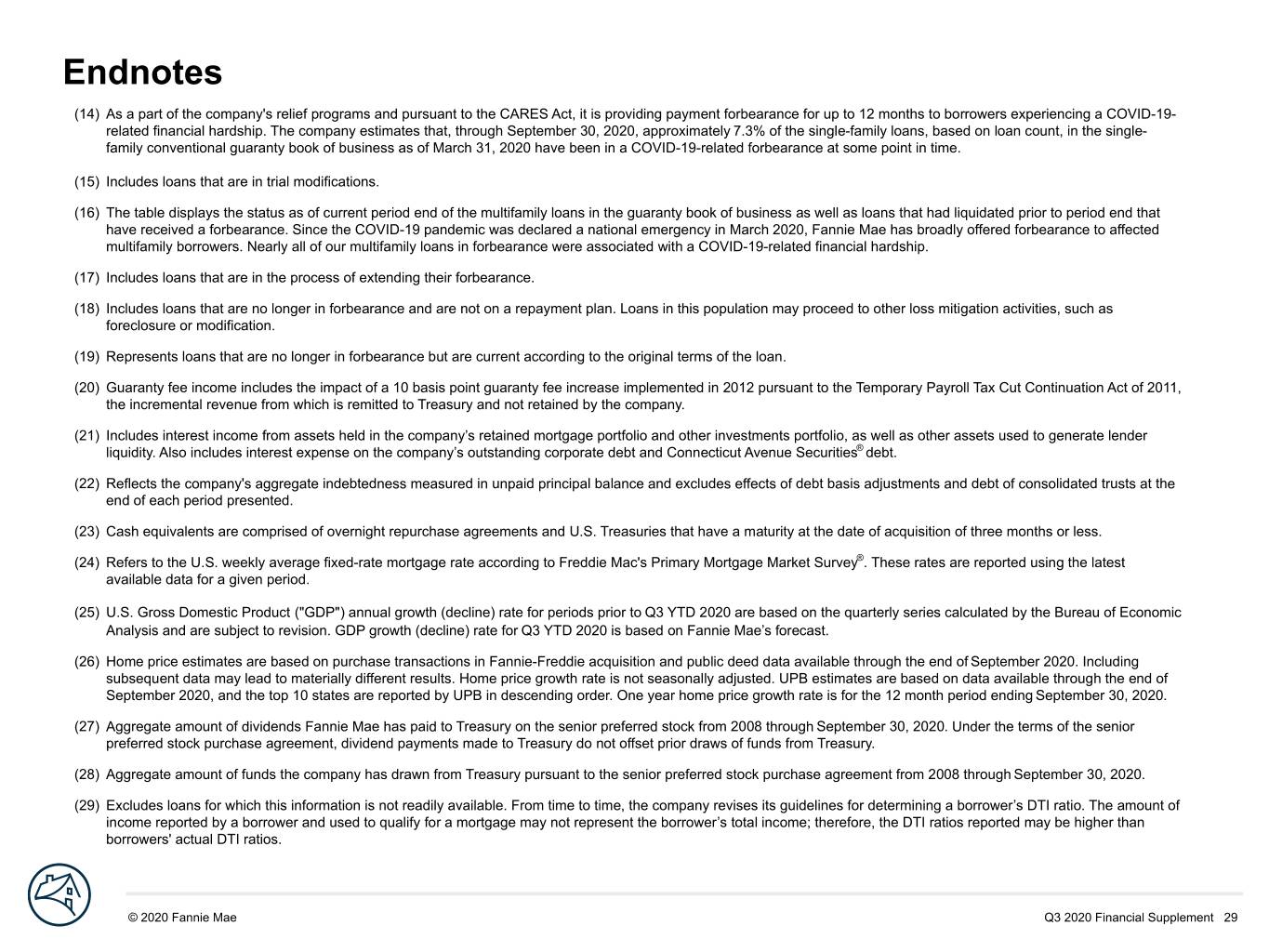
DRAFT Endnotes (14) As a part of the company's relief programs and pursuant to the CARES Act, it is providing payment forbearance for up to 12 months to borrowers experiencing a COVID-19- related financial hardship. The company estimates that, through September 30, 2020, approximately 7.3% of the single-family loans, based on loan count, in the single- family conventional guaranty book of business as of March 31, 2020 have been in a COVID-19-related forbearance at some point in time. (15) Includes loans that are in trial modifications. (16) The table displays the status as of current period end of the multifamily loans in the guaranty book of business as well as loans that had liquidated prior to period end that have received a forbearance. Since the COVID-19 pandemic was declared a national emergency in March 2020, Fannie Mae has broadly offered forbearance to affected multifamily borrowers. Nearly all of our multifamily loans in forbearance were associated with a COVID-19-related financial hardship. (17) Includes loans that are in the process of extending their forbearance. (18) Includes loans that are no longer in forbearance and are not on a repayment plan. Loans in this population may proceed to other loss mitigation activities, such as foreclosure or modification. (19) Represents loans that are no longer in forbearance but are current according to the original terms of the loan. (20) Guaranty fee income includes the impact of a 10 basis point guaranty fee increase implemented in 2012 pursuant to the Temporary Payroll Tax Cut Continuation Act of 2011, the incremental revenue from which is remitted to Treasury and not retained by the company. (21) Includes interest income from assets held in the company’s retained mortgage portfolio and other investments portfolio, as well as other assets used to generate lender liquidity. Also includes interest expense on the company’s outstanding corporate debt and Connecticut Avenue Securities® debt. (22) Reflects the company's aggregate indebtedness measured in unpaid principal balance and excludes effects of debt basis adjustments and debt of consolidated trusts at the end of each period presented. (23) Cash equivalents are comprised of overnight repurchase agreements and U.S. Treasuries that have a maturity at the date of acquisition of three months or less. (24) Refers to the U.S. weekly average fixed-rate mortgage rate according to Freddie Mac's Primary Mortgage Market Survey®. These rates are reported using the latest available data for a given period. (25) U.S. Gross Domestic Product ("GDP") annual growth (decline) rate for periods prior to Q3 YTD 2020 are based on the quarterly series calculated by the Bureau of Economic Analysis and are subject to revision. GDP growth (decline) rate for Q3 YTD 2020 is based on Fannie Mae’s forecast. (26) Home price estimates are based on purchase transactions in Fannie-Freddie acquisition and public deed data available through the end of September 2020. Including subsequent data may lead to materially different results. Home price growth rate is not seasonally adjusted. UPB estimates are based on data available through the end of September 2020, and the top 10 states are reported by UPB in descending order. One year home price growth rate is for the 12 month period ending September 30, 2020. (27) Aggregate amount of dividends Fannie Mae has paid to Treasury on the senior preferred stock from 2008 through September 30, 2020. Under the terms of the senior preferred stock purchase agreement, dividend payments made to Treasury do not offset prior draws of funds from Treasury. (28) Aggregate amount of funds the company has drawn from Treasury pursuant to the senior preferred stock purchase agreement from 2008 through September 30, 2020. (29) Excludes loans for which this information is not readily available. From time to time, the company revises its guidelines for determining a borrower’s DTI ratio. The amount of income reported by a borrower and used to qualify for a mortgage may not represent the borrower’s total income; therefore, the DTI ratios reported may be higher than borrowers' actual DTI ratios. © 2020 Fannie Mae Q3 2020 Financial Supplement 29

DRAFT Endnotes (30) Refers to HomeReady® mortgage loans, a low down payment mortgage product offered by the company that is designed for creditworthy low-income borrowers. HomeReady allows up to 97% loan-to-value ratio financing for home purchases. The company offers additional low down payment mortgage products that are not HomeReady loans; therefore, this category is not representative of all high LTV single-family loans acquired or in the single-family conventional guaranty book of business for the periods shown. See the “OLTV Ratio > 95%” category for information on the single-family loans acquired or in the single-family conventional guaranty book of business with origination LTV ratios greater than 95%. (31) "Refi Plus" refers to loans acquired under Fannie Mae's Refi Plus initiative, which offered refinancing flexibility to eligible Fannie Mae borrowers who were current on their loans and who applied prior to the initiative’s December 31, 2018 sunset date. Refi Plus had no limits on maximum LTV ratio and provided mortgage insurance flexibilities for loans with LTV ratios greater than 80%. (32) Calculated based on the aggregate unpaid principal balance of single-family loans for each category divided by the aggregate unpaid principal balance of loans in the single-family conventional guaranty book of business. Loans with multiple product features are included in all applicable categories. (33) Percentage of loans in the single-family conventional guaranty book of business, measured by unpaid principal balance, included in an agreement used to reduce credit risk by requiring collateral, letters of credit, mortgage insurance, corporate guarantees, inclusion in a credit risk transfer transaction reference pool, or other agreement that provides for our compensation to some degree in the event of a financial loss relating to the loan. (34) Amortized origination loan-to-value ratio is calculated based on the current UPB of a loan at period end, divided by the home price at origination of the loan. (35) Based on the unpaid principal balance of the single-family conventional guaranty book of business as of period end. (36) Refers to loans included in an agreement used to reduce credit risk by requiring primary mortgage insurance, collateral, letters of credit, corporate guarantees, or other agreements to provide an entity with some assurance that it will be compensated to some degree in the event of a financial loss. Excludes loans covered by credit risk transfer transactions unless such loans are also covered by primary mortgage insurance. (37) Outstanding unpaid principal balance represents the underlying loan balance, which is different from the reference pool balance for CAS and some lender risk-sharing transactions. (38) Includes multifamily loans that are in an active forbearance as of September 30, 2020. (39) Calculated based on the unpaid principal balance of loans in forbearance with the specific credit characteristic and vintage divided by the total unpaid principal balance of loans in forbearance in that origination year at period end. (40) Share of Single-Family Conventional Guaranty Book based on UPB was calculated based upon the unpaid principal balance of loans in forbearance by vintage divided by the total unpaid principal balance of the single-family conventional guaranty book of business at period end. (41) Measured from the borrowers’ last paid installment on their mortgages to when the related properties were added to our REO inventory for foreclosures completed during the nine months ended September 30, 2020. Home Equity Conversion Mortgages insured by the Department of Housing and Urban Development are excluded from this calculation. (42) Consists of (a) short sales, in which the borrower, working with the servicer and Fannie Mae, sells the home prior to foreclosure for less than the amount owed to pay off the loan, accrued interest and other expenses from the sale proceeds and (b) deeds-in-lieu of foreclosure, which involve the borrower’s voluntarily signing over title to the property. (43) Consists of loan modifications and completed repayment plans and forbearances. Repayment plans reflect only those plans associated with loans that were 60 days or more delinquent. Forbearances reflect only completed forbearance arrangements that involve loans that were 90 days or more delinquent. Excludes trial modifications, loans to certain borrowers who have received bankruptcy relief that are classified as troubled debt restructurings, and repayment and forbearance plans that have been initiated but not completed. © 2020 Fannie Mae Q3 2020 Financial Supplement 30

DRAFT Endnotes (44) Credit losses consist of (a) charge-offs net of recoveries and (b) foreclosed property expense (income). Percentages exclude the impact of recoveries that have not been allocated to specific loans. (45) For a description of our Alt-A loan classification criteria, refer to the glossary in Fannie Mae’s 2019 Form 10-K. The company discontinued the purchase of newly originated Alt-A loans in 2009, except for those that represent the refinancing of a loan acquired prior to 2009, which has resulted in the acquisitions of Alt-A mortgage loans remaining low and the percentage of the book of business attributable to Alt-A to continue to decrease over time. (46) Total amount of single-family credit losses includes those not directly associated with specific loans. Single-family credit losses by state exclude the impact of recoveries that have not been allocated to specific loans. Presents the five states with the highest credit losses for the applicable period among the company's top ten states by percentage of outstanding single-family conventional guaranty book of business. (47) Defaults include loan foreclosures, short sales, sales to third parties at the time of foreclosure and deeds-in-lieu of foreclosure. Cumulative Default Rate is the total number of single-family conventional loans in the guaranty book of business originated in the identified year that have defaulted, divided by the total number of single-family conventional loans in the guaranty book of business originated in the identified year. Data as of September 30, 2020 is not necessarily indicative of the ultimate performance of the loans and performance is likely to change, perhaps materially, in future periods. (48) Represents the percentage of loans with lender risk-sharing agreements in place, measured by unpaid principal balance. (49) Under the Delegated Underwriting and Servicing (DUS) program, Fannie Mae acquires individual, newly originated mortgages from specially approved DUS lenders using DUS underwriting standards and/or DUS loan documents. Because DUS lenders generally share the risk of loss with Fannie Mae, they are able to originate, underwrite, close and service most loans without a pre-review by the company. (50) Includes any loan that was underwritten with an interest-only term less than the term of the loan, regardless of whether it is currently in its interest-only period. (51) See https://www.fanniemae.com/multifamily/products for definitions. Loans with multiple product features are included in all applicable categories. (52) The Multifamily Affordable Business Channel focuses on financing properties that are under an agreement that provides long-term affordability, such as properties with rent subsidies or income restrictions. (53) In Q1 2019, the DUS program updated the definition of small multifamily loans to any loan with an original unpaid balance of up to $6 million nationwide. The updated definition has been applied to all loans in the current multifamily guaranty book of business, including loans that were acquired under the previous small loan definition. (54) Cumulative net credit loss rate is the cumulative net credit losses (gains) through September 30, 2020 on the multifamily loans that were acquired in the applicable period, as a percentage of the total acquired unpaid principal balance of multifamily loans in the applicable period. Net credit losses include expected benefit of freestanding credit enhancements, primarily multifamily DUS lender-risk sharing transactions. (55) Includes loans that were delinquent upon the expiration of the forbearance arrangement and did not enter into a modification or other loan workout. © 2020 Fannie Mae Q3 2020 Financial Supplement 31
